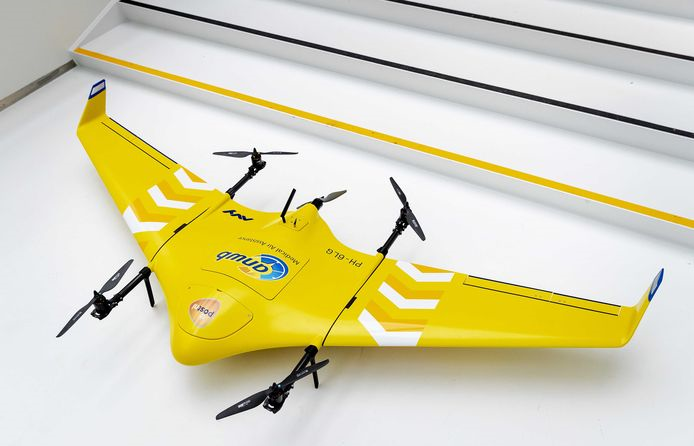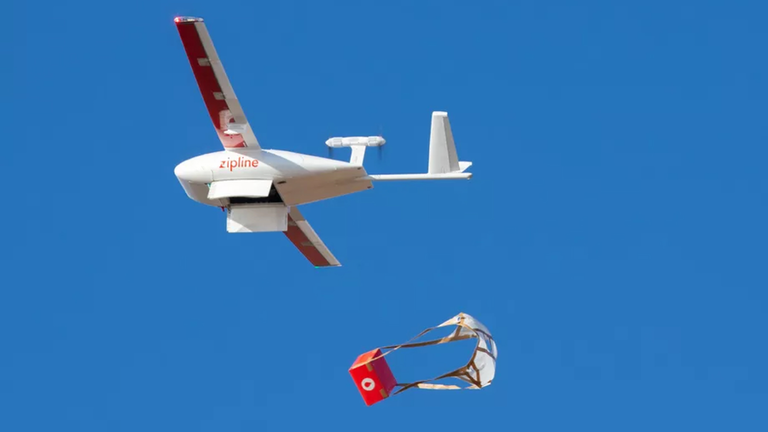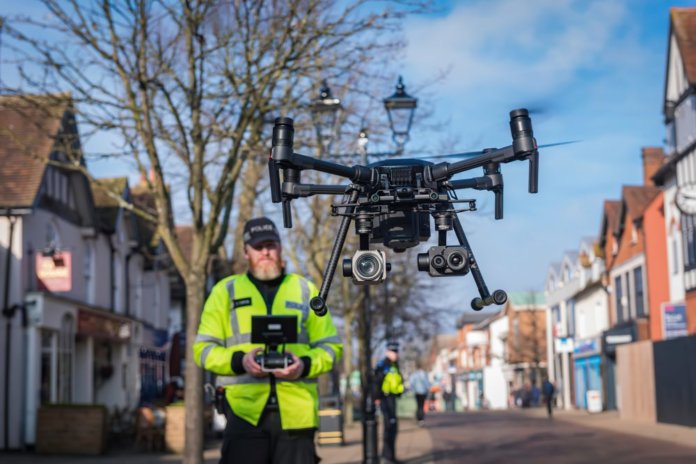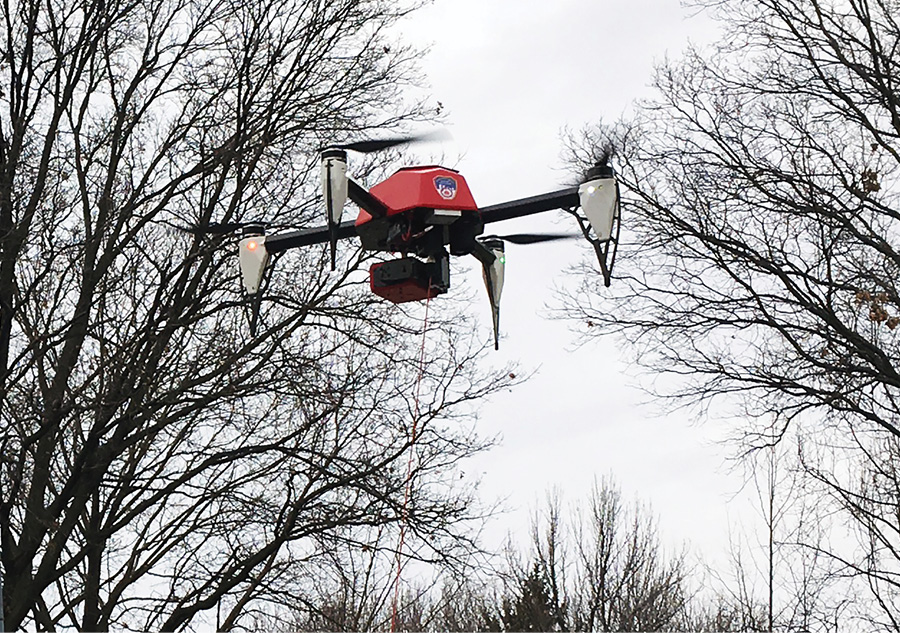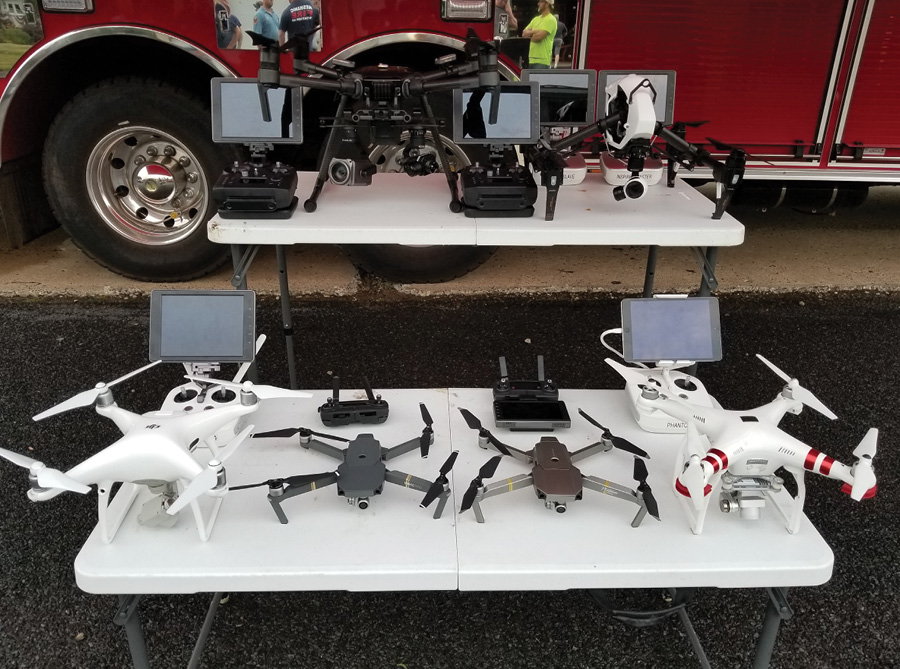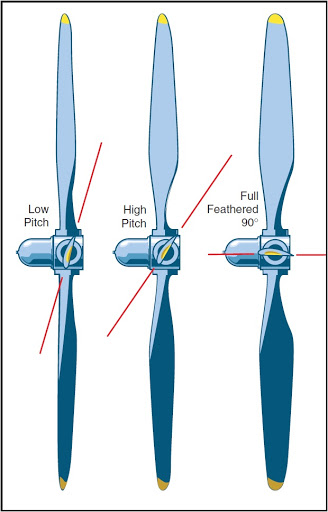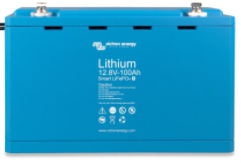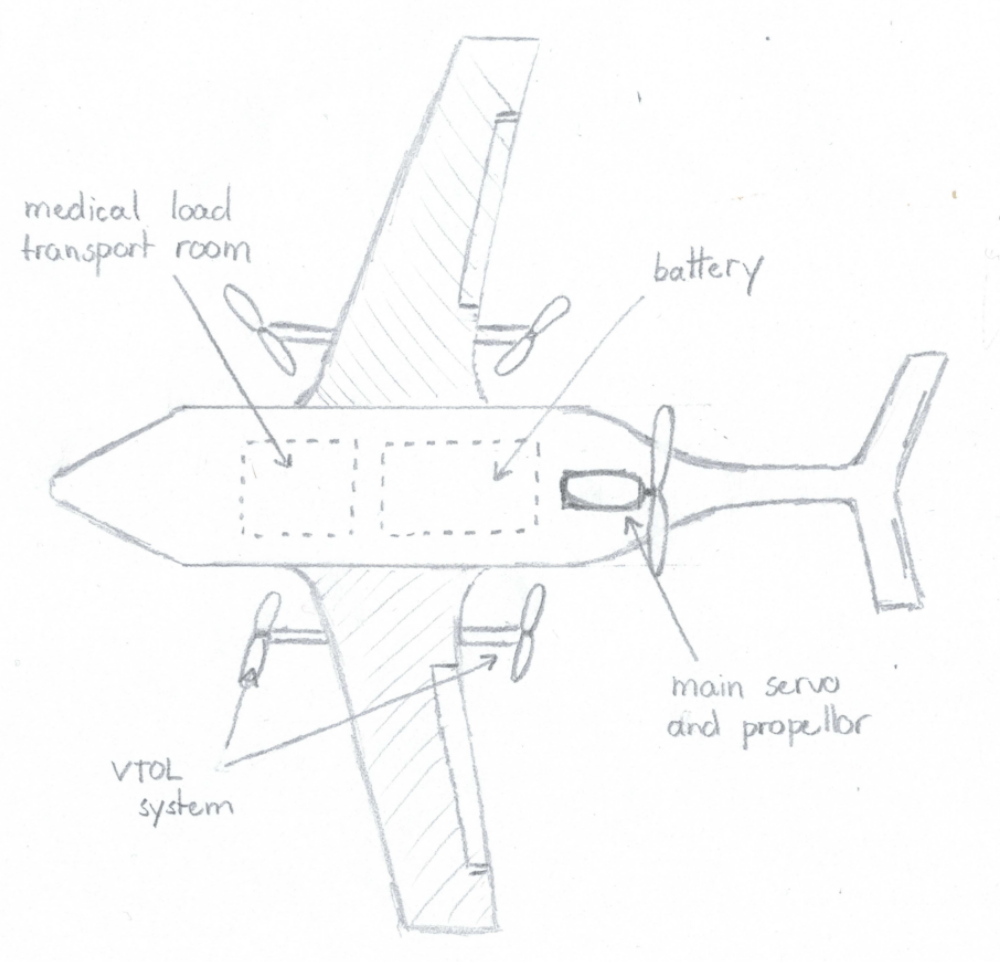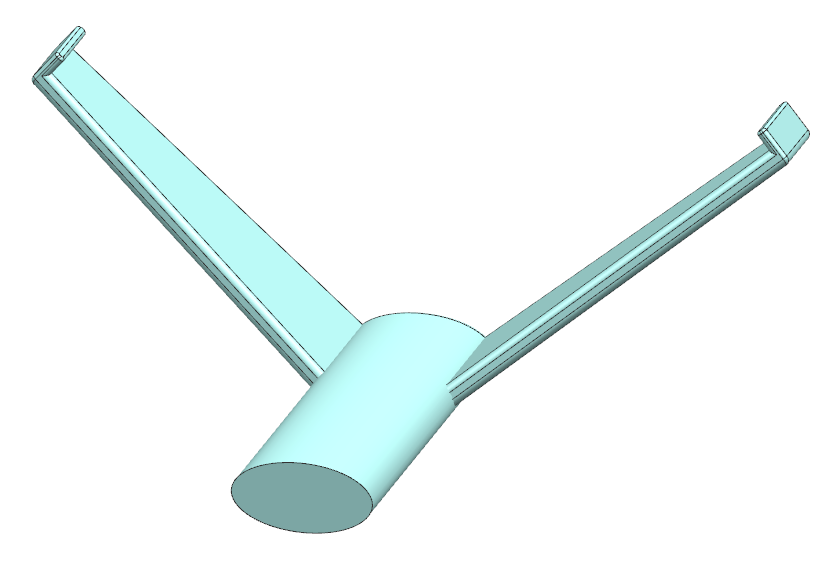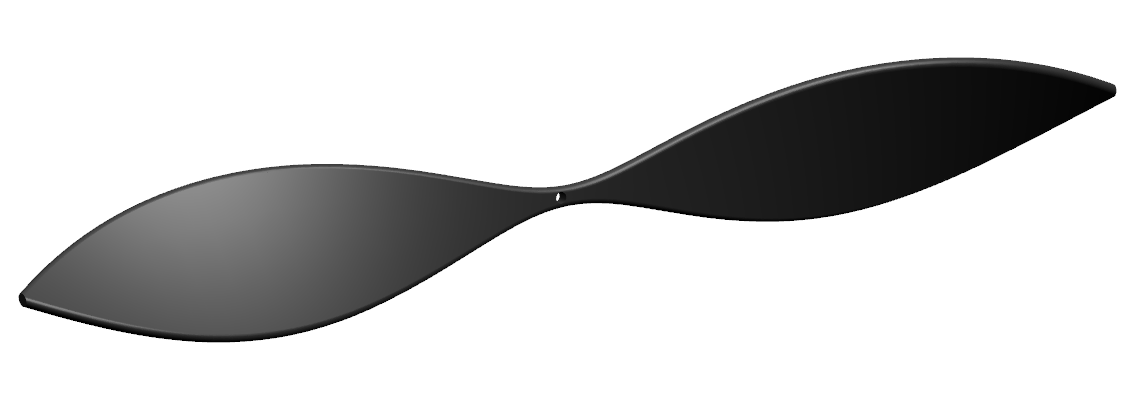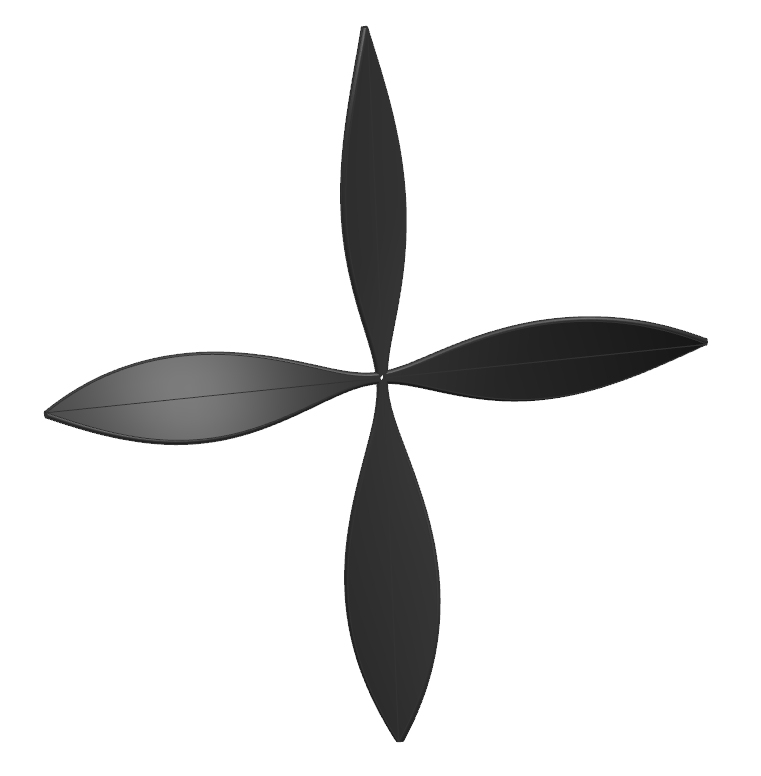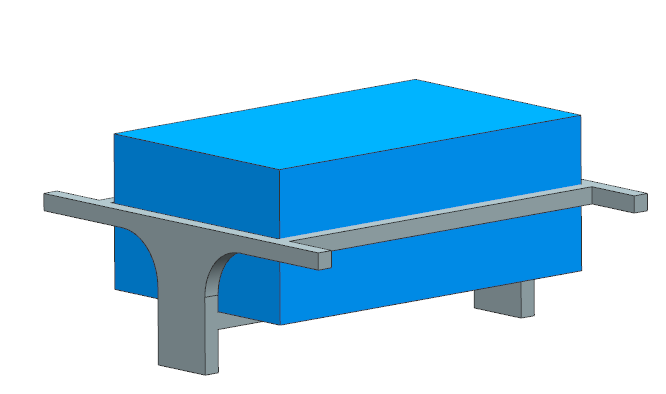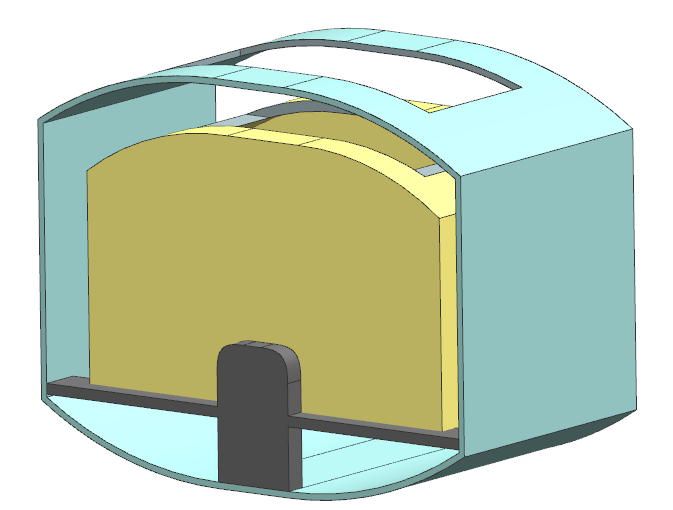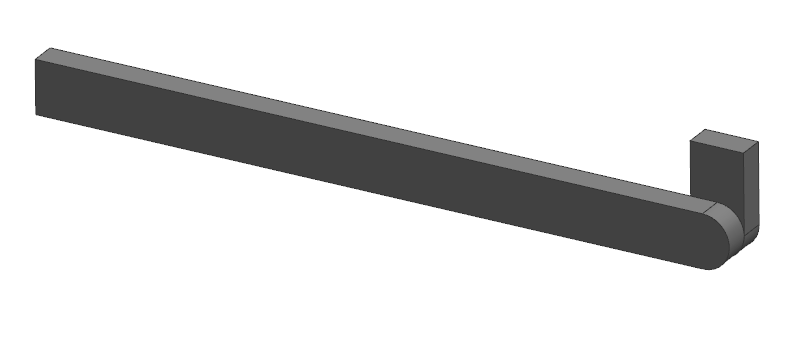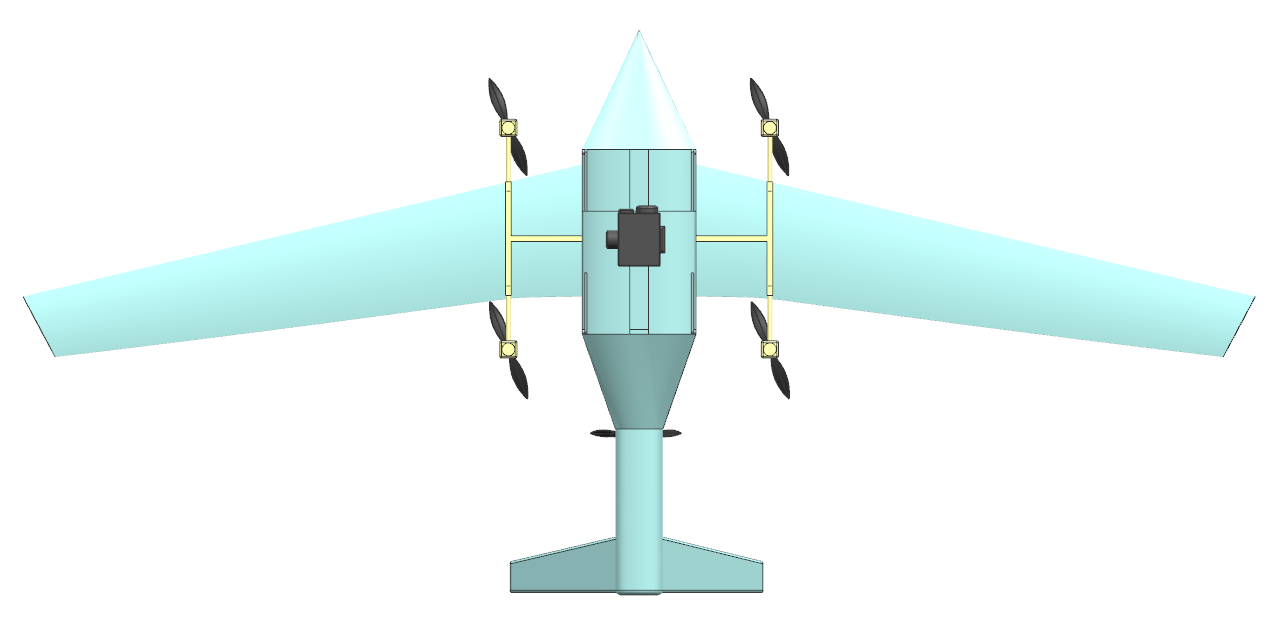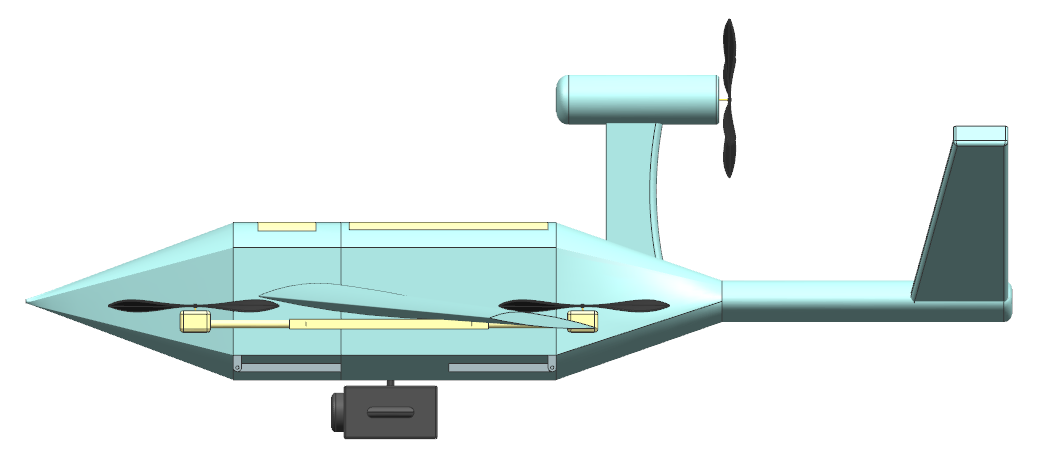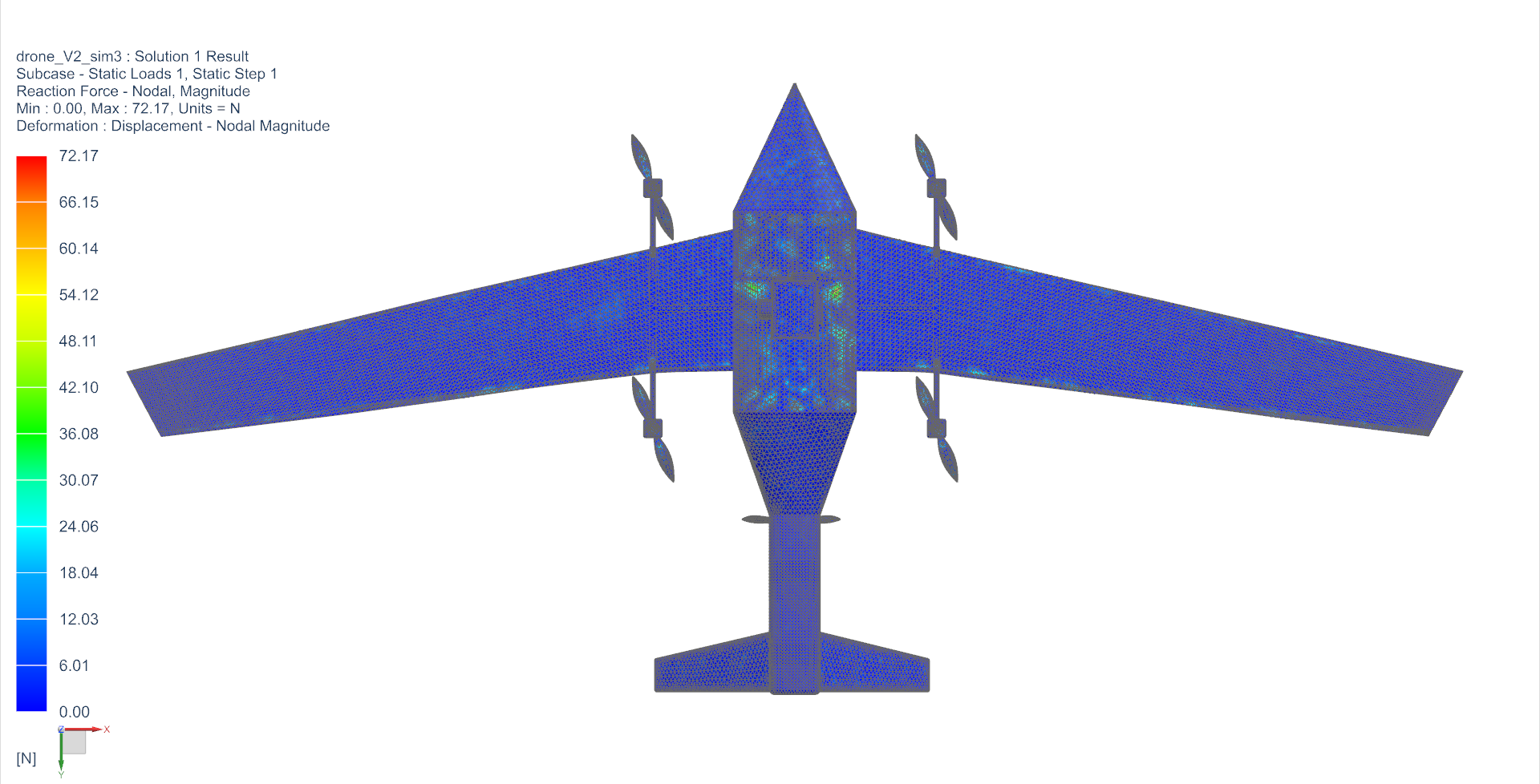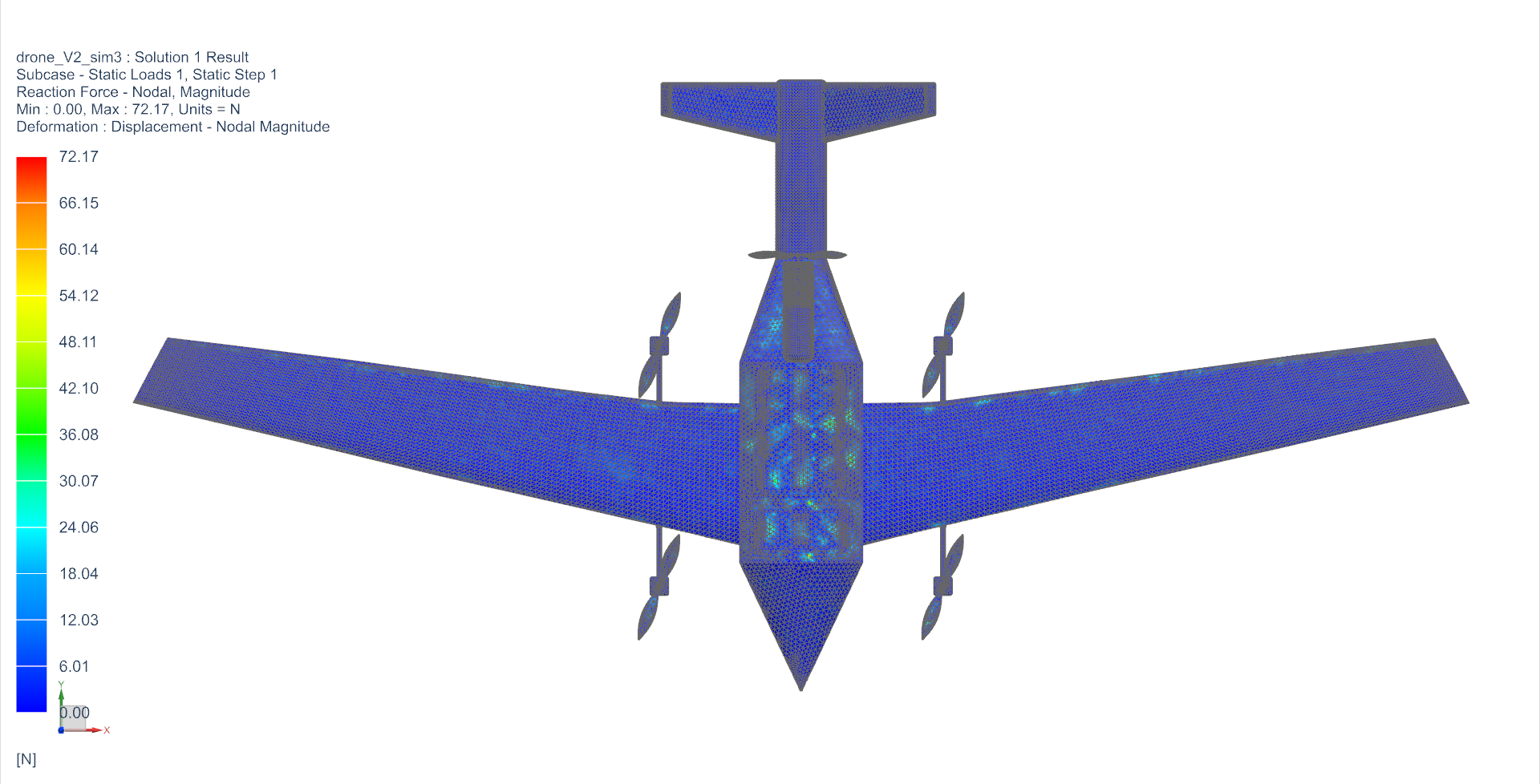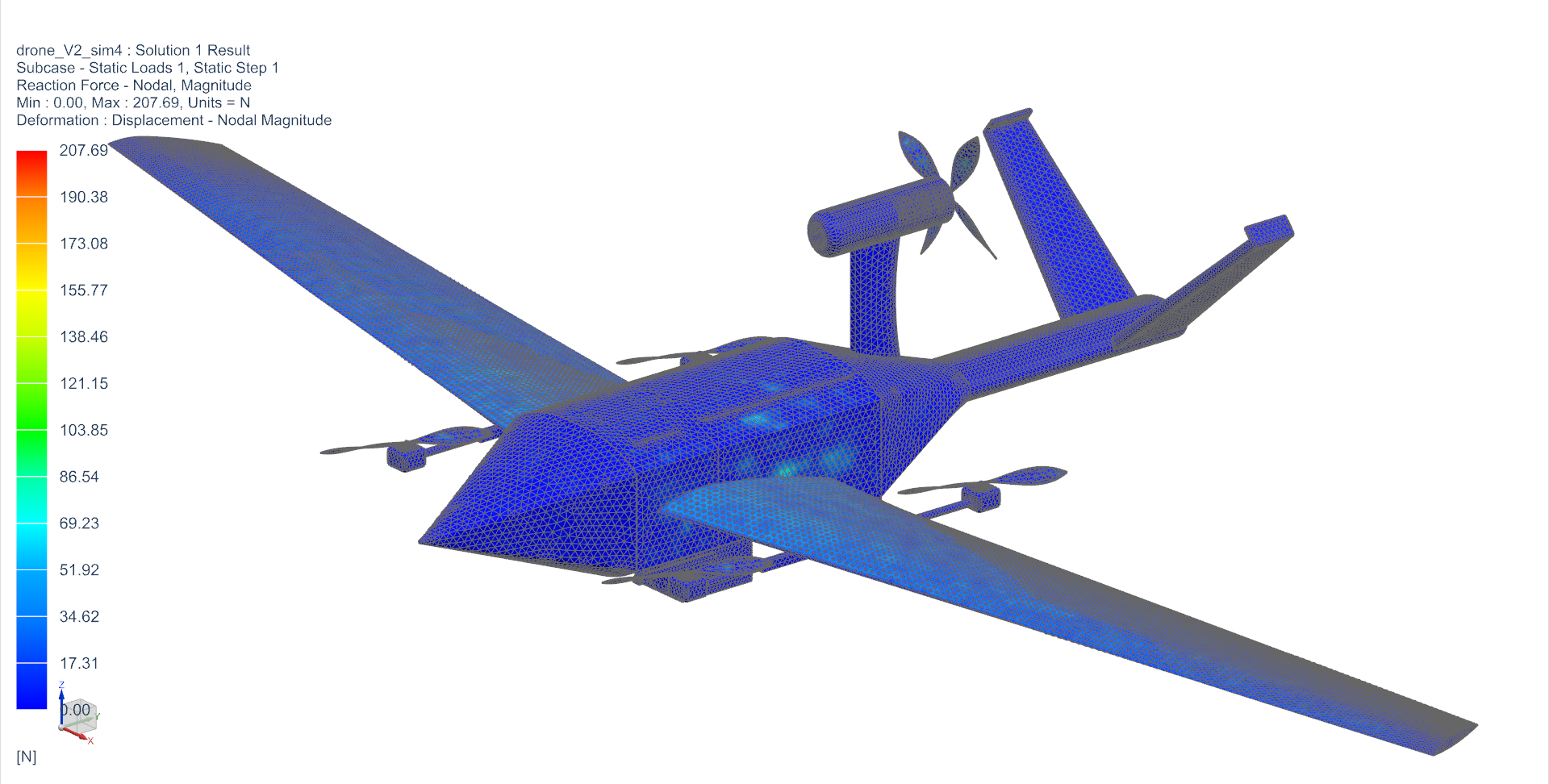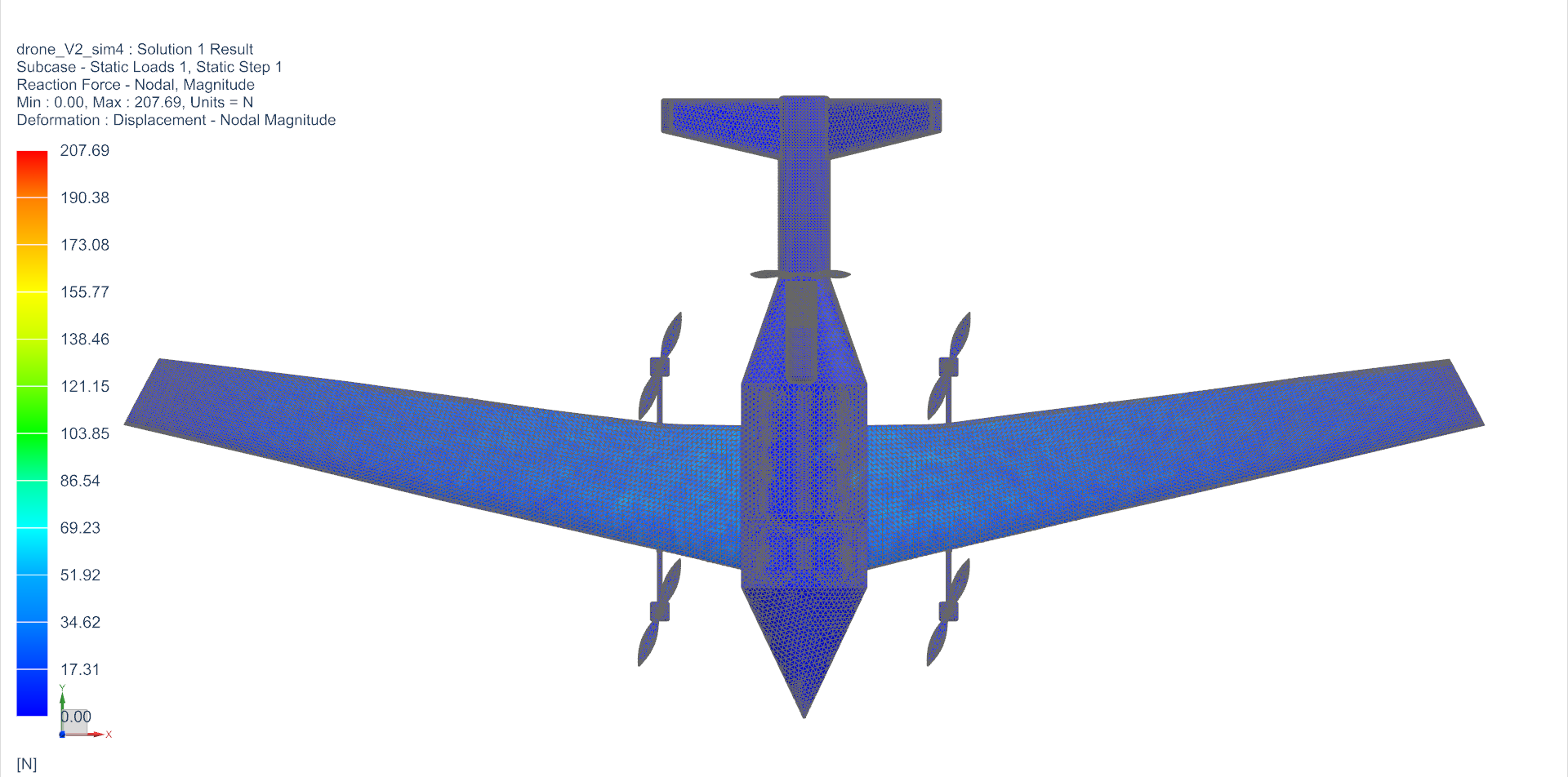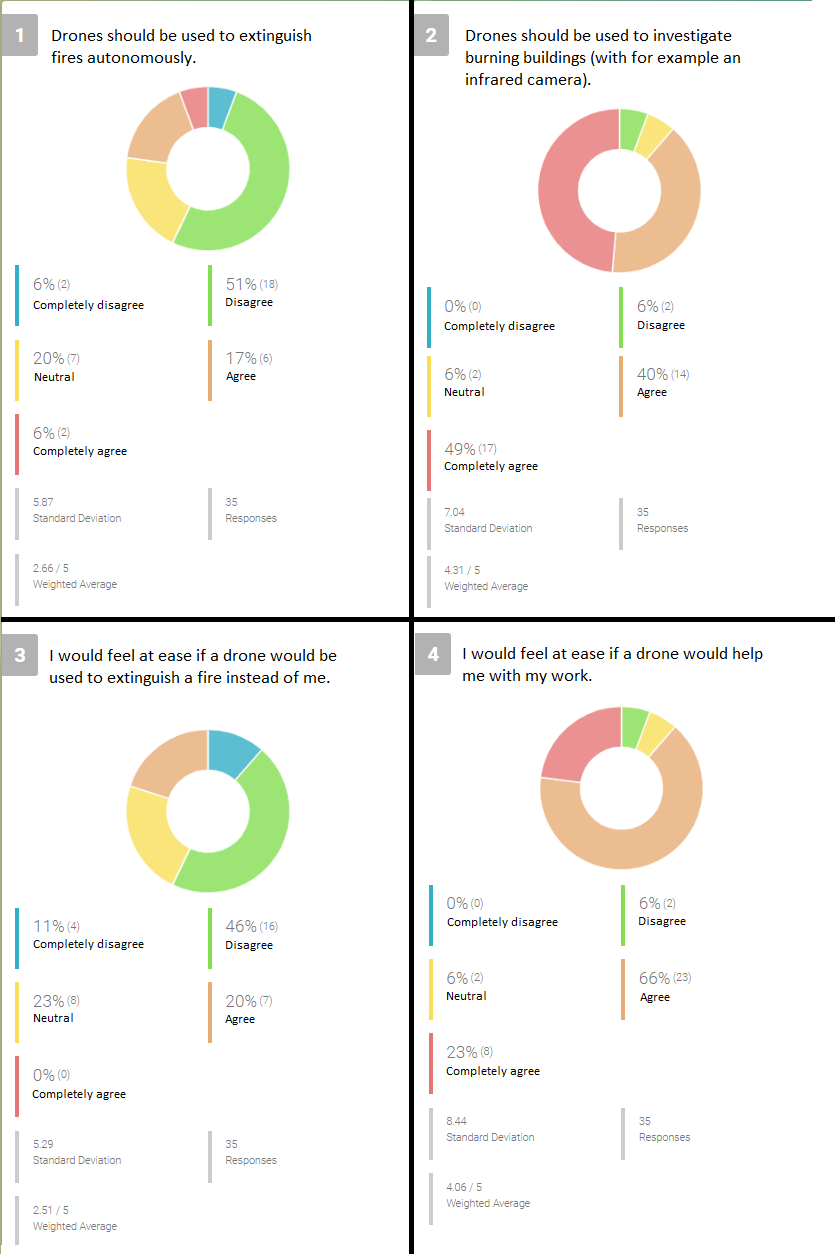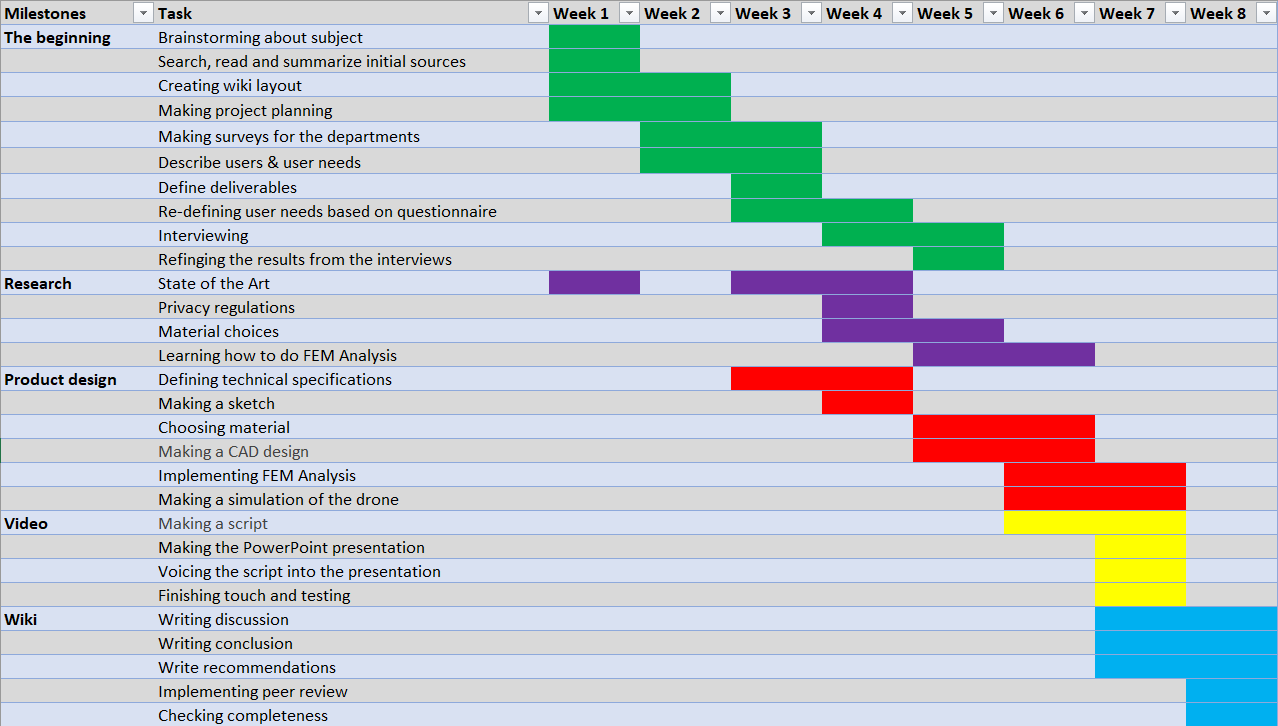PRE2020 3 Group5
Emergency Drone
Group Members
| Name | Student ID | Department | Email address |
|---|---|---|---|
| Pepijn Hundepool | 1427520 | Mechanical Engineering | p.c.j.hundepool@student.tue.nl |
| Lucas Commissaris | 1451065 | Mechanical Engineering | l.f.h.commissaris@student.tue.nl |
| Sven Passier | 1448781 | Mechanical Engineering | s.w.l.passier@student.tue.nl |
| Bram van den Buijs | 1464647 | Applied Physics | b.v.d.buijs@student.tue.nl |
| Stijn Borgers | 1495968 | Applied Physics | s.borgers@student.tue.nl |
Problem statement and objectives
The popularity and usage of compact unmanned aerial vehicles (UAVs), better known as drones, has been increasing radically over the past few years [1]. For only a rather small amount of money, you can already get yourself a drone with some basic abilities. In general, three types of drone users are distinguished. The majority of the drones that are made, are made for military purposes. An increasing part of the drones are made for consumers (e.g. hobbyists) and commercial usage. The commercial usage groups will be the point of focus for this project. These drones can have a broad range purposes, such as 3D mapping, delivery, inspections, data transmissions, video collection, etcetera. Although the commercial usage group represents the lowest percentage of sales of the three aforementioned sectors, the revenue value in 2016 was about 60 percent more than the one from consumer purchases. This phenomenom is mainly caused by the fact that price tags of about $100,000 are no exceptions in the commercial sector.
A sector that does not really match the term 'commercially' as it regards the type of institution, but does regarding the production's price tag, are drones used by governmental bodies. In specific it concerns departments that are of key-importance in emergency situations, with the three most central ones being respectively the police, firefighting and medical (ambulance) departments. In these departments, try-outs and permanent involvements of drones become more and more part of the job [2]. However, since these drones often include high-advanced technologies, their production costs can rise to serious heights. A proper police drone for example lies in the purchasing range from $50,000 to $200,000 [3].
This project aims to develop a new type of drone, which will be able to carry out tasks for more than one of these departments. Roughly sketched, this will result in a drone with a range of different functions, combining the strenghts of the three departments. This multifunctional drone will have multiple benefits over the development of drones that are specified per department. A benefit is that drones can be used more efficiently at for instance an incident or natural disaster, where often more than one department is providing assistance. Since the cargo can be varied for multiple departments, different tasks can be executed with the same drone. As a result, when at a certain moment in time a department is not using their drone(s), other departments can make use of it instead.
Another benefit concerns sparsely populated areas. In such places budget could form a problem to invest in modern technologies such as drones. However, there still might be the need for an emergency transport of blood, or some oversight at an accident. If one drone could be deployed for both tasks, which might only occur once in a while, then only one drone has to be invested in. The resulting difference in purchase costs between multiple separate or one multifunctional drone will not be explored in detail here, but one could assume the following: If the specialized department’s drone would only differ from the multifunctional drone in terms of specific equipment (e.g. a camera), the savings from production costs for separate frames can be significant. If then the most important specific equipment/functions are combined with the frame into one drone, it can just make the difference for it to be invested in.
Deliverables
This project aims to have the following deliverables at the end of the quartile:
- A study on the experiences and thoughts of the primary users on drones for their expertise.
- A conceptual CAD model of an emergency drone, which should be able to be used by all three main departments. This model will focus on the design and type of functions it should be able to perform, to a great extent based on the primary user study, rather than show a detailed view on the exact controls that would be required.
- A FEM-analysis on the CAD-model, to show the impact of external forces on the model.
- A simulation of the CAD model in Simcenter to show how the drone will propel.
- A wiki page that shows the consecutive steps that have been taken to accomplish the deliverables stated above.
USE Analysis
In this section the different stakeholders of our project will be investigated and summarized.
Users
The primary users of the emergency drone are the civil servants that work in the fire, police and medical department. To be more specific: within the fire department the drone will be used as a fire-reconnaissance tool, within the police department it will be used for surveillance and finally within the medical department the drone will be used for the transport of goods between hospitals in an emergency. These are the main uses of the drone but the fire and police department can also make use of the drone's ability to transport goods, for example if they need a specific type of equipment at a remote location a.s.a.p.. The medical department can make use of the areal reconnaissance ability as well to give a birds eye view of an otherwise chaotic situation.
The secondary users are all civilians. Civilians could be trapped inside a burning building, they could be under surveillance or they could be in a hospital with the need for a certain essential good that the hospital doesn't have, like a certain blood type. In all these cases, civilians are on the receiving end of a emergency drone, in some cases more direct then others.
Sampling the users
We wanted to confirm and further investigate the user needs, so we set up a questionnaire for each of the three departments. We asked a few questions about technical specifications and how drones could be used best. We also asked them about their attitude towards the implementation of drones into their work to confirm that the users would want to use drones, this is not necessary for the result of our project but it does help confirming the usefulness of it.
After realizing that an interview would be more beneficial for our research, we conducted one. Elaboration can be found in the section below. We did not get any response from the police department. Neither with the questionnaire nor the interview (of which the emails were send to multiple addresses).
Questionnaire
The answers we got from the questionnaire were the answers we expected but we were still missing something. We realized that the questionnaire would either need to be reformulated so that the answers would be useful to us or we had to find another way to get information. In the end we decided to conduct an interview. The reasoning was that if we were to get in contact with even one person that is working with drones, we would be able to obtain more knowledge then with an answer of a multiple choice question. Even an answer to an open question would be subpar in a questionnaire compared to an interview. Interviews allow for more room to ask further questions that come to mind and the danger of a questionnaire is that questions can easily be misinterpreted, while in an interview you can state more clearly what exactly is meant by the question.
The results of the questionnaire can still be found in Appendix C.
Interviews
To have a more in-depth understanding of certain technical difficulties and choices, we tried to interview some people from each of the three different sectors. The contacted people specialized in the development of the drones to support their respective sectors. We have interviewed 4 people in total and summarized their answers to the different interview question. We will first introduce the participants. Below that will be questions and summarized answers (results).
People
Here the people that we have interviewed will be introduced.
Fire department:
1. Mark Bokdam (Linkedin): Chief officer of the fire department in Twente and a board member at the SWOD foundation on behalf of the Dutch Fire Department. He has worked for the fire department for over 11 years and is the contact for any questions about the drones teams of the fire department.
2. Robbert Nijs (Linkedin): Policy advisor IRA (information, research and analysis) for Mid- and West-Brabant. 19 years of experience with working for the fire department. He is now a part of one of the drone teams for the fire department.
Medical department:
1. Jaap Hatenboer (Linkedin): Vice president and the Policy and Innovation manager at UMCG Ambulancezorg. In his daily life he deals with new developments surrounding transportation in the health sector. But also the organization of the healthcare department he works in.
2. Mirjam Meerkerk: Paramedic and part of Axira. Axira is a partnership between independent regional organizations that now operates nationally for ambulance care. They say that they combine their knowledge and experience to make innovations faster, better and cheaper
[4].
In Anne-Jan's daily life he encounters accidents, cerebral infarction, people in panic and he uses psychiatry to calm victims and/or their relatives.
Questions and answers
Here you can find the questions and the answers from the interviews. The answers will be combined and summarized for the convenience of the reader.
Fire department:
- How do you see drones be used by the fire department?
The drones that are used in The Netherlands today are for areal reconnaissance. These drones are equipped with an optical camera (DJI Zenmuse Z30) and an infrared camera that also has an optical camera inside of it (DJI Zenmuse XT2), so it can produce a video with both optical and infrared footage overlapped.
- Drones are not used to extinguish fires in The Netherlands. Why?
Water is quite heavy, so to compensate the forces to carry and fire this water, the drones will have to have quite a lot of power. This means these drones will be very heavy, think anywhere from 30 to 400 kg. China is already testing with these drones ( [5]). Robert Nijs doubts that these things can extinguish fires that are inside the building. These drones might be able to carry a good amount of water up, but a fire truck will most of the time be more useful. The one exception is if there is a fire in a high story building (which are quite common in China) where a fire truck will probably have difficulties reaching that high, but a drone can just fly up there. According to Mark Bokdam, The Netherlands will start experimenting with firefighting drones within 5 years.
- Do you think it is possible? Maybe even autonomously?
According to Mark Bokdam, The Netherlands will start experimenting with firefighting drones within 5 years. To have a drone being fully autonomous is a whole other question because a drone needs to be supervised otherwise we encounter a responsibility problem. Who will be held responsible for the things that the drone does? The supervisor? The software engineer? The person that mobilized the drone?
- In which range of fires do you see a drone being deployed? Is it useful to deploy a drone for all types of fire?
In most situations a birds eye view is a good information gatherer for a situation with a lot of unknowns.
- Would transporting equipment be useful? Which equipment?
Probably not, because most of the equipment of the fire department is quite heavy and most of the time the ground vehicles can arrive at the location within 5-10 minutes. In most situations this time is short enough to save the situation and the people inside them. Having a single fire extinguisher or a fire blanket arrive 3 minutes earlier does not have a major impact. Maybe in the future.
- How much should a drone be able to carry?
The current drones weigh around 4.5 kg. Lightweighted sensors can be carried for the surveillance, but a useful amount of water for extinguishing fires by no means.
- What type of drone would be the most useful? A quadcopter, a fixed wing drone, or a hybridcopter (which is a combination of both)?
Fixed wing/hybridcopter is useful for surveying large fires, such as forest fires. This type of drones has not yet been implemented, but it would be a good addition to the tools available. The drones that are currently in use at the fire department are quadcopters, these drones provide a birds eye view with both an infrared camera and an optical camera.
- How can your drones be improved?
Longer batteries, better sensor package, stronger rotors, basically just standard technological improvement. The other thing is the previously mentioned fixed wing drones which can survey large areas and can stay in the air longer.
Medical department:
- How do you see drones be used by the medical personnel?
Mostly as an information gatherer, so the same as the eye in the sky concept the fire department stated. These types of drones will give a visual overview of the situation for the medical personnel so they wont get surprised by unexpected circumstances when they arrive.
- Would using drones to transport equipment between hospitals be useful? Equipment examples: Blood, vaccins, organs, antidotes or first-aid-kits
Helicopters are quite expensive to use. The cost of the vehicle, fuel and the education of a pilot is high. This creates a situation where only in very high demanding situations a helicopter is mobilized and not in all of the situations where the medical helicopter is required can it be mobilized. Transportation using drones is a nice mid-way solution between mobilizing a helicopter and a land vehicle. These drones can be instantly mobilized with small packages of whatever is necessary to whatever location.
- Would it be useful to transport an AED, organs, antidotes or a first-aid-kit using drones for an emergency call?
Transportation of AED's seem to be quite succesfull in populated areas, with enough volunteers that are able to use the equipment properly (ongoing research Göteborg, Sweden). However, for a cardiac arrest, the drone should be at the required location within 6 minutes for it to be of use. As a result, drones should already (constantly) be in the sky, at moment at which the emergency call is made, in order to be close enough already at that point.
- How much should a drone be able to carry?
Around 5kg. This should be enough to carry a sensor package, with an optical camera, an IR camera and maybe a large light. This light will make it easier for the medical personnel to work at night time.
- What type of drone would be the most useful? A quadcopter, a fixed wing drone, or a hybridcopter (which is a combination of both)?
Quadcopter: surveillance / eye in the sky. But sometimes not even this. Jaap Hatenboer argues that it will be more useful to have a fixed wing drone fly loops around the scene. This would make the drone more efficient in energy use and it will create a situation where the drone will have a view of the situation from a wide variety of angles. Fixed wing drone: Long distance flights between developed locations, such as hospitals or bloodbanks. Hybridcopter: Long distance deliveries to for example an emergency caller. It will be difficult for a drone to be useful when the situation is indoors. But the drone might be able to transport aids for the person in distress.
So, most drones can be of use in the medical department, it just depends on the situation. The quadcopter might be the most useless one, especially when technology is able to create a virtual recreation of the situation by having imagery from different angles. This will make a fixed wing drone flying a pattern above the situation more useful.
- How can your drones be improved?
Standard technological improvements like stated in the fire department section.
Society
There are different stakeholders to be considered for the influence of the society. The government is a major stakeholder, because of the legislation of drones for emergency usage. Animal rights and environmental organizations have a large interest in maintaining and/or improving the current situation. The drone technology could be dangerous and do damage to society. The flying stakeholders who are using the airspace now must also be taken into account, like bird, planes or other drones.
There can also be a positive effect on society that would be beneficial on a great scale. When a drone would deliver an AED within 6 minutes, the survival chances would increase significantly. Every minute that passes after those initial 6 minutes decreases the chance of survival by 10 percent. The average time it take for an ambulance to arrive is 9 minutes [6]. However we got from our interviews that in populated areas there will already be a volunteer resuscitating with an AED before the ambulance arrives. This means it would only be useful in unpopulated areas and in the Netherlands we are quite packed so it is not that useful here. In sweden however it has already been implemented [7]. Other medical usage would be the transport of blood or organs. For the other two departments an eye in the sky is highly beneficial in certain situations because with the information the drone provides, the efficiency and accuracy that the members of the police and fire department can work at will increase. All of this would in turn increase the safety and survivability of civilians and save precious time.
Enterprise
In order to realize emergency drones, the product needs to be produced by a technology company. This company will only build, deliver, and repair these drones. The company will work closely together with a government agency. This agency will be responsible for the usage and quality of the drones, after they have been bought from the drone company. A close cooperation between both stakeholders will lead to a better end product.
Whenever an accident happens due to a drone malfunctioning, the governmental agency will be held responsible. Because of this, the agency will have to test each drone thoroughly, to limit the risks of accidents. The government agency will also be ultimately responsible for the usage of data gathered by drones. The government agency will have to check with the police, medical and fire departments how they deal with the information and data form the drones and if all drone deployment regulations are complied. The relation between the agency and the departments could be seen as principal-agent relationship.
When civilians have an unpleasant experience with the usage of drones by the police, medical or fire department or when they simply feel disturbed by the usage of drones in general, the government agency will be contacted. The agency should write a simple report about each of these complains. The agency should also have the tools to track down the specific drone and flightpath, to see if any regulations on drone deployment where infringed.
Use Cases
Here we will describe three different (one for each department) examples of where drones have been used in practice.
Fire department [8]
The fire department gets a call that there is smoke coming from a forest. It is hard to get there and also difficult to locate the fire and thus difficult to decide what the next steps will be. Therefor a drone will be used to locate the fire. This type of drone is a VTOL fixed wing drone and this the drone is able to fly large distances in a short time period. Also it is more efficient to fly this way than a rotary drone. Another benefit is than the drone does not need a takeoff and landing place, because the drone can take of vertically. The drone locates the fire and it will circle above the area where the fire is located. With this drone, the fire department has a better overview and is able to make better decisions.
Police department [9]
A police station is informed about a missing person case. The missing person went out on a walk in a rural area in the afternoon, however the person was still not back home at 9pm. This caused family to inform the police. The police has a rough idea on where the person could be, however since it is a rural forest area, searching by foot and with cars is slow. The police has other options at hand, one of which is the police helicopter. With the help of a helicopter a large area can be scanned quickly and infrared cameras will help locating the missing person. However, the police can also decide to use their VTOL fixed wing drone. The local police station has one of these drones and the drone has already proven to be a reliable option in missions from the past. It is decided to use the drone instead of the helicopter, since it is more cost-effective. The drone is being transported by car to the edge of the forest. Here the drone is launched and the search for the person starts. Due to the high quality camera and infrared camera, the missing person is located within 40 minutes. Police officers rush to the location and the person is transported by the local police, to a hospital for a medical check.
Medical department [10]
There is a blood shortage in the hospital and it is necessary that there is blood present. Using a helicopter would be too expensive and going by car brings the risk of delay because of traffic. A VTOL fixed wing drone would be a great solution, it can carry the necessary blood fast to the hospital. No extra takeoff and landing place is needed, because it can do this vertically. Zipline is using a fixed wing drone for blood delivery in Africa. Zipline wants to use these drone to transport vaccines. Especially during the COVID-19 pandemic, the VTOL fixed wing drone would be highly beneficial, because it can easily deliver the vaccines anywhere. With this drone everything can be on time and easily transported.
Legal requisites
From the interviews we realized that there was quite some difficulty with conflicting laws when using drones. In this section we will cover two areas where the usage of drones has been limited or adjusted. In each area we will explain how the laws are conflicting, how much the drone pilots should be allowed to do in order to execute their job unhindered and how the laws should change for this goal. The two areas that we will be covering are laws concerning privacy and aviation.
Privacy law
Finding the balance between helping people the best as possible and maintaining their privacy is a difficult issue. Without permission from the people in the video footage, it may not be stored. According to the General Data Protection Regulation (GDPR), it is the right to erasure the footage of the people who are in it. This will make it harder to use footage for training purposes or to analyse the situation. To know if the emergency could be handled differently, the footage can be studied and methods could be improved. That is a major benefit from the videos. The downside is that not everyone would feel comfortable being filmed by a drone. Also the accidents could be horrifying to look at afterwards. It could probably make a difference if people know were it is for, but it should be communicated clearly. We do not want to maintain the footage for an indeterminant amount of time, but keep the footage for a certain amount of time if necessary. This will maintain people’s privacy and it will benefit the emergency response units to get a better overview of the situation [11].
According to our interviews, we can conclude that the fire department thinks that drones would be accepted and until now, there has not been any complaints about privacy. They handle there images well and blur the people involved in the footage. The medical department thinks that in urban areas, it will become more difficult to convince the people. Also they believe that recognizable medical drones will be seen as less of a burden instead of pizza delivery drones. Therefor emergency drones would be publicly acceptable.
Aviation law
As of 31 December 2020, the European rules apply for drones. These rules are applied in all the counties in the European Union. There are three categories which depends on the risks: flights with a low risk level, flights with a medium risk level and flights with a high risk level. Each risk level has different rules and requirements. Low risk is under the open category, therefor no authorization or declaration by the operator is required. Medium risk is under the specific category, therefor a Specific Operations Risk Assessment, AESA authorisation and STS and predefined risk assessment EASA. High risk is under the certified category, therefor certified operator, certified UAS, licenced pilot and delegated regulations EU
[12].
In the table below the different risk levels are stated with their rules and requirements in the Netherlands
[13].
| Low risk | Medium risk | |
|---|---|---|
| The requirements for drones | • The drone has to be less than 25kg • Maximum height of 120 meters • No transport of hazardous substances • Nothing may be dropped out of the drone • You must always have a visual on the drone |
• It is allowed to fly above people • It is allowed to fly in the neighborhood of aerodromes • The drone may be above 25kg • The drone may fly above 120 meters • The drone may drop something • The drone may be out of sight |
| The requirements for drone pilots | • The age must be 16 years or older • Someone under the age of 16 years can fly if there is an observer with a pilot’s license • You must have your pilot’s license with you when you use your drone • You won’t fly in restricted areas • Not under influence of alcohol or drugs • You are not allowed to flight in the neighborhood of emergency services • You land your drone when other air traffic approaches • Respect other people’s privacy, so filming with permission |
• The owner of the drone should be registered (by the RDW in the Netherlands) • The pilot should be licensed • The operator must do a risk analysis before flying with the drone • The operator must have a flight permit (of ILT in the Netherlands) |
The rules and requirements for high risk drones are still in development. The EASA expect to have these rules by the second quartile of 2021.There are more rules and exceptions, like a toy drone with a maximum of 250 gram has no registration for the pilot and doesn’t have to do a knowledge test.
The picture below gives a clear overview of the rules and requirements of the usage of drones which are stated in the table.

Below is a map of the flight regulations in the Netherlands.

Red: No-fly zone
Blue circle: only flying with permission of the administrator
Pink: Low flight area, only flying allowed when someone else is present
Green: Natura 2000 area which has a drone prohibition Yellow: Short term events that are temporarily off-limits Orange: Dangerous area, because it is close to an uncontrolled airport or it is inside a PJE (Parachute Jumping Exercise) area
On this map you can see that determining whether you may fly even an authorized drone can be quite difficult and would require you to first look at this map and determine if there is no interference. This might be an encumbrance for an emergency respondant to have to find out if they may fly a drone in the area or not. Therefore we suggest either an automated version where they would be notified of problems, or that someone can find out whether they may fly a drone when the emergency respondants are on their way to the location. The time it takes to check this with the map above (which is a live map) should be within 30 seconds when someone that is experienced with the software checks it. Because of the interviews and our research we got to know that, apart from the the driver and the navigator, there is not much to do for the fire department when they are driving to a destination. This means they might be able to check whether they can fly a drone in the area. Another option would be that emergency drones could get an exception for certain no-fly zones. This would help the departments substantially with their crisis.
State of the Art
Here we elaborate on what we have investigated about the current technological limit of drones. After doing a user analysis we concluded the best drone to develop would be one that has the ability to give a birds eye view to the users and one that has the ability to transport a small load in an emergency situation. We thought this type of drone would be the most beneficial to all departments.
Transport drones
Medical drone service
Drone company AVY and several partners are currently testing a long range drone delivery service [16]. The consortium, called Medical Drone Service, will research how the system can impact healthcare in the Netherlands. This consortium consists of several companies, that each have their own expertise; the most important ones are: The ANWB (who are also behind the medical helicopters), PostNL (postal logistics), Erasmus MC (hospital) and Sanquin (blood bank).
During this pilot, a distance of 15 km is travelled in a sparsely populated area, and in the current stadium no medical equipment is yet transported. The main transport is meant to consist out of e.g. medicines, blood and urgent medical deliveries [17].
The drone flies autonomously, but is constantly monitored and at any time the control can be taken over. This specific drone is the AVY Aera, which is also called a Vertical Take Off and Landing wing drone. This term, as you might expect, means that it can take off and land vertically, and subsequently fly horizontally. This can be of great advantage in crowded areas, as the vertical landing makes large landing strips redundant. The drone has a wingspan of 2.5 meters and flies with a speed between the 70 and 80 km/hour, which it can maintain for about an hour. The height it flies at is about 100 meters and at the moment it can only transport a maximum load of 1.5 kilograms. An example of a technical challenge that this drone faces is to maintain a certain temperature, as blood has for instance ideal temperatures at which it should be transported [18]. In addition, it doesn’t fly at bad weather conditions.
Zipline drone network
Blood transport
The American drone company Zipline created the world’s first ever drone delivery network for blood transportation in Rwanda (Africa), in October 2016 [19]. Zipline has distribution centers from where the drones are launched. These centers also perform the function of storage and warehousing of blood and the drones. When a doctor places an order for blood to the distribution center (e.g. through a message or call), workers at Zipline takes the blood from the refrigerator, wraps it with insulated paper and packs it in an insulated cardboard box, after which it is loaded in the drone. Subsequently, the drone takes off to deliver the cargo to one of the clinics.
Zipline uses planes instead of quad copters (which uses four rotors), as quad copters uses far more energy to fly. They can’t manage the range from batteries necessary to travel longer distances and are relatively slow as well. On an average, one delivery is completed in 15-45 minutes and it takes 5-7 minutes to launch the drone after receiving the order. Zipline handles approximately 500 deliveries per day. These drones travel with a speed of 100 km/hour, with a range of over 160 km (allowing the drone an 80 km zone around the location). When the drone reaches the delivery location, it descends to 30 feet to deliver the packet.
About the physical components of the drone. It has a wingspan of 3 meters and the maximum load it can handle per flight is 1.8 kilograms. The batteries (lithium ion batteries with a total capacity of 1.2 kilowatt hours) are the heaviest part of the aircraft, making up half of the total weight of the aircraft, weighing a total of 10 kilograms. The aircraft itself thus weighs about 20 kg.
The drone has a few specifics that are worth mentioning. Instead of a regular GPS circuit, a detachable battery is used in which a GPS is present. This was done as the regular one experienced delay when connecting to the satellite. Another point is the fact that the cargo is dropped with a little parachute. As a result, the clinic at which it is delivered does not require any additional infrastructure to land the drone, and the drone can immediately return to the distribution center. The landing system for the drone is impressive and complicated at the same time. At the distribution center, two actuated arms are located, between which a wire is strung. The drone flies towards the arms, which catch a hook attached to the drone, and brake and end the drone’s flight.
Vaccine transport
The company Zipline, which is also behind the delivery drone network for blood discussed above, are starting this spring with delivering COVID-19 vaccines [20]. This will be done in the regions in which they are already active, for example Rwanda, Ghana and Tanzania, but also rural parts of the U.S.
A big challenge presented by many of the vaccines, is their temperature requirement. The Pfizer vaccine for instance has to be stored at minus 70 degrees Celsius. To overcome this issue, Zipline will store vaccines in ultra-cold freezers at its distribution centers, and when a clinic needs vaccines, the drones can make a delivery within roughly half an hour. As a result it allows rural and remote health facilities to bypass the need for having the freezers themselves.
Surveillance/reconnaissance drones
Eye in the sky
On their website the West Midlands Police in the UK discuss the way drones can be used to assist officers in scanning large areas in a short amount of time [21]. These areas being: crime scenes, hard to reach areas, major incidents or looking for missing persons. The drones cost between 2.000 and 10.000 pounds (2.320-11.600 euros). The drones are operated by specially qualified officers that have trained under the Civil Aviation Authority (CAA) regulations. The drones are used for a short 15 minute period of time to minimize noise concerns. The drones are allowed to fly up to 120 meters high. The smallest drone has a top speed of 65 km/h. The drones can fly within 500 meters of the pilot. They make use of a lithium-polymer battery that can be charged either in buildings or on police vehicles.
The Fire Department of New York (FDNY) has been using tethered drones at incident scenes since March 2017. [22] The HoverFly drones are equipped with video and infrared cameras. They are able to evaluate fire travel, structural issues like cracks in a building or danger of collapse, and roof operations to determine if anything is unsafe and needs corrective action. HoverFly drones have a constant power source and are able to give very clear pictures. The drones are operated by pilots that are part of a command tactical unit that is dispatched from the FDNY command center.
The Millstone Valley (NJ) Fire Department in Franklin Township Fire District No. 1 uses DJI drones [22]. First they had an off-road search and rescue team that used Polaris Ranger utility terrain vehicles and a 4×4 brush truck but then they realized how practical a drone would be. In the first year of usage, they found multiple lost hikers using drones. Millstone Valley also has used its drones on special call from the New Jersey Forest Fire Service, for prescribed burns and uncontrolled wildfires. With the drones, they are able to determine where the fire is and to predict where it goes.
Design research
Here we will state our findings that were eventually used to come up with a conceptual design for the drone.
Drone requirements
Before we could make a start on the actual design of the drone, we first needed to know what the purpose of the drone is and for what department the drone will work. This was not completely clear until the interviews were done. From these interviews it was concluded that a single drone design could benefit the medical, police and fire department. In order to start the design phase, the most important tasks of each of the departments were listed. Since both police and fire department would have the same requirements for the drone [23] [24], these departments were listed together the table below. The medical department had other requirements for a drone, so this department was listed in a separate column.
| Police and fire department | Medical department | |
|---|---|---|
| Flight speed | Preferred to be high: drones can view the location from large distance and most of the time it will only be hovering in the air, however the drone will need to be on location quickly. | Needs to be high: to deliver the package as quickly to the location as possible and to compete with ground delivery |
| Flight endurance | Preferred to be high: reconnaissance missions can take long, however landing and recharging does not have to take a long time | Needs to be high: has to be able to make it to the location |
| Payload | Needs to be quite high: the sensory package can weigh upwards of 5 kilos | Needs to be high: blood and organs can be quite heavy in combination with all sensors required to fly |
| Stability | Needs to be stable: the camera can stabilize small disturbances but not all | Not required: the packages will be attached firmly to the drone frame |
The correct drone type
We then had an idea on some requirements for each of the drones. We started looking at the state of the art of drones and what drones would fit the best for our cases. We looked at rotary drones, fixed wing drones and VTOL (Vertical Take-Off and Landing) fixed wing drones, these can be seen in the figure below from left to right.
| Rotary | Fixed wing | VTOL fixed wing | Sources | |
|---|---|---|---|---|
| Fly speed | 60-80kph max | 80kph + (highly depended on wing shape and size) | 80kph + (highly depended on wing shape and size) | [25] |
| Flight endurance | 30 min average | 3-12hr | VTOL part +/-15min, Fixed wing part (2-12hr) | [25] [26] [27] [28] [29] [30] |
| Payload | 3-5kg (depends on drone size) | 2-10kg (depends on size) | 2-10kg (depends on size) | [25] [26] [27] [28] [29] [30] |
| Stability | Good | Good | Good | [25] [26] [27] [28] [29] [30] |
| Take off space | Not required | 0-10m (depends on size and weight and take off system) | Not required | [27] |
| Landing space | Not required | 0-30m (depends on size and weight and landing system) | Not required | [27] |
| Camera suitability | Very stable, even used in movie making | Good | Good | [25] [26] [27] [28] [29] [30] |
Recommendation
Based on the table above and all the typical specifications for each of the drone types For the police and fire department we recommend to use a VTOL fixed wing drone, it can hold a camera and has high flight time. Both of these factors are important key aspect to support the police and fire department. The medical department will also benefit from a fixed wing VTOL drone since has a high endurance and high fly speed. The drone is also able of taking off and landing anywhere, making it easy to fly from A to B.
Propellor
Regarding a desired flight velocity and energy consumption, the design of a drone’s propellor is of great importance. For a multirotor propellor there are a few key variables that need to be considered in the its design: The size, the pitch, the blade configuration and the material [31]. These variables discussed here will mainly hold for rotary drones, but the general aerodynamics and energy consumption can be also be used for other drone types (e.g. fixed wing).
First of all, the size. The main difference between a small and large propellor is the power consumption and level of thrust. Larger propellors sweep more air and thus take more energy to get spinning. These will have more thrust and can fly more steadily. Smaller ones require less power and will be able to change altitude more rapidly. Just as important as these considerations, is the requirement of a well matched motor. If a small propellor is placed on a motor made for bigger sized propellors, it will lead to a too high RPM (Rotations Per Minute) with very little thrust. A typical diameter is around 8 to 9 inches [32].
The pitch of a propellor refers to the angle of each of the blades on the propeller. A high pitch will lead to more overall thrust and top speed, while a low pitch increases the response time and uses less power. A propellor with low pitch is only efficient at low speeds, while a high pitch is more suitable for flying in large open areas.
The amount of blades on a propellor is referred to as the blade configuration. Increasing the amount of blades will not have that much of an effect as increasing the size. Many blades are more suitable when flying in places where making fast turns is a requirement, while less blades are when thrust is less critical. In general, tri-blade propellors provide the best balance between efficiency and thrust [33].
Finally, the material of the propellor, for which polycarbonate is a very common option, known for its good stiffness. Material choice depends also on the climate in which the drone is operating. In a hot climate for instance, glass fiber might be needed to reinforce the propellor, as other materials (e.g. polycarbonate) can become soft and thus less efficient.
Rotor
A rotor is the common name for the combination of a motor with a propellor. In general, multiple rotors are either symmetrically or co-linearly attached to a drone’s frame. There are a few key specifications for these motors. The operating voltage is typically 11.1 or 14.8 Volts, in combination with a three or four cell Li-Po battery. Another important variable is the amount of kilovolt of the motor, which is also indicated as the rotation speed per Volt. From this relation it becomes immediately clear that the propellor will spin faster at a higher kV (RPM/V) rating. However, it is important to keep the balance between the amount of kV and the size of the propellor. For instance, a too high kV combined with a too large propellor will require more torque and can subsequently generate too much heat or even overheating [34]. The weight of one single rotor is usually between the 12 and 20 grams.
The table below provides an indication of several components of a drone (a quadcopter specifically here) relate to each other [35].
| Frame size | Prop size | Motor size | Energy |
|---|---|---|---|
| 150mm or smaller | 3" or smaller | 1306 or smaller | 3000KV or higher |
| 180mm | 4" | 1806 | 2600KV |
| 210mm | 5" | 2204-2206 | between 2300KV and 2600KV |
| 250mm | 6" | 2204-2208 | between 2000KV and 2300KV |
| 350mm | 7" | 2208 | 1600KV |
| 340mm | 8", 9", 10" | 2212 or larger | 1000KV or lower |
For drones, two main types of motors are distinguished: Brushed and brushless [36]. This distinction is based on the way of generating a magnetic field, which is done through permanent polarity for a brushed one and switching polarity (with a permanent magnet) for the brushless one. The brushed version is commonly used for very basic (consumer) drones, while the brushless one is often used in larger drones, as it has a wider speed range and longer lifespan.
With this knowledge and the info from the table can be concluded that a brushless motor should be used, in combination with a KV value that is not too high. Since the frame from the drone that is to be designed for this project will be near the 450 mm or even a bit more, the lower row of the table will be taken as reference, with the KV of 1000 or lower.
Power Source
Combustion engines
A drone will need a power source to power the propellers and generate lift. There are different ways of powering a drone. Most drones use batteries to power their electric components. The most batterie for powering a drone is a Lithium-ion (Li-ion) battery. Not every battery is meets the requirements for powering a drone. The battery needs to have a high discharge rate, high energy/weight ratio and a fuel gauge is essential for showing the user when a landing is required.
When drones get bigger, they generally have the ability to lift more weight. Especially in fixed wing and VTOL fixed wing drones, the market shows that when drones get larger in size the way of powering a drone changes. Since becomes bigger, the possibility of using an combustion powered engine opens up. These engines are able of powering the drone for long periods of, dependent on the size of the fuel tank. In 2017, MIT engineers build an gas powered fixed wing drone, that was able of staying in the air for 5 days. The engines used in these drones are usually one or two cylinder engines, weighing between 1.3 to 7.3kg and they have power outputs ranging from 1.6kW to 18.9kW
[37].
A fixed wing drone will need one combustion engine to operate, however a VTOL fixed wing drone will also need additional batteries to supply power to the propellers performing the vertical take-off and landing. An endurance focused VTOL fixed wing drone can be called a ‘hybrid’, since it combines multiple energy sources. An example of such endurance focused drone is the ALTI Transition
[38],
this drone combines an electric and fuel power and is ably to fly up to 12 hours.
However, the drone that is to be designed in this project, does not have the requirement to fly for such a long time. As stated already above, there is a wide range of fuel motors that are used in UAVs [39]. When looking into one of the smallest versions, a 32 cc [40], it becomes clear that these already can bring along some practical problems. For this one, the basic engine weight is already 1.3 kg, while in total with all components/accesoires it sums up to about 2.7 kg. In addition, it of course will need fuel to run, 93 octane to be precise. Such a fuel has a density in the range from 0.715-0.790 kg/L [41]. On a long flight, e.g. 120 km, a minimum of about 5 kg of fuel will be required. Combining this with the engine’s weight, a total of 8 kg will be represented by this part of the drone alone.
This is especially high when comparing it to the weight of components for the current relevant drones, as discussed in Chapter 5. The weight of a Zipline drone’s battery for instance is about 10 kg, while a drone with a fuel motor (especially of this size) will need electric support as well, subsequently exceeding this value with a significant amount. Furthermore, on a societal note, with the rapid developing energy-transition in mind, the usage of fuel is also not likely to stay relevant and ‘acceptable’ for many years.
Battery packs
The battery pack used by the Zipline drone comes down to a total capacity of 1.2 kWh. Such a range should also be strived for the drone to be developed here, as a similar size and transport load will be used. Then there are two options: Either to use multiple, separate batteries (e.g. for each rotor one), or to implement one larger one, that is connected to all rotors via a circuit. The latter one seems to be the most space-efficient option, as these packs can be quite robust. Since the middle part of the drone will already contain some sort of bulge, the drone’s frame only has to be adjusted to the battery pack here, instead of at multiple spots (e.g. towards the sides/wings).
For non-consumer drones (the scope outside the hobbyists), the specific battery packs used are often not revealed or at least can not be found easily. Therefore, a reference battery pack will be used, the ‘Victron lithium accu’ [42], which also has a capacity of about 1.2 kWh. This one is not specifically created for the usage of drones. It weighs 4 kg more than the one Zipline uses, which makes a significant difference of 40 percent in weight. From this one can assume that the volume of the two packs will also differ with a similar percentage. Therefore, in the CAD model, the battery pack will be modelled with the dimensions of the Victron lithium scaled with a factor of 0.71, to make it more realistic.
Cameras
In our interview with Robbert Nijs (see interviews) he mentioned the types of cameras that are currently used within his field. The drones that are used in the Netherlands are equipped with an optical camera (DJI Zenmuse Z30) and an infrared camera that also has an optical camera inside of it (DJI Zenmuse XT2), so it can produce a video with both optical and infrared footage that are overlapped.
Material
An important preference of any aerial vehicle is to be as lightweight as possible [43]. With this main preference in mind, there are several other material aspects that are important for a certain vehicle. Airplanes for example use aluminum because of it being lightweight, yet strong, allowing the plane to carry more weight or become more fuel efficient. The 2014 aluminum alloy will be used for the main body of our drone.
Insulation
To provide a proper transport possibility, the transport cabin's material should meet the conditions of the to be transported goods. For the medical department, a variety of things could be transported, among which for instance blood bags (or samples) and organs. For both of these, preservation will only be feasible when it lies in a certain temperature range. For whole blood (standard donated blood) and red cells, this range is between +2 and +6 degrees Celsius [44]. For most organs, the temperature should be slightly higher, as 4 to 8 degrees Celsius is the standard range for these [45].
When the drone is to be travelling long distances, e.g. between hospitals, it should be able to meet such temperature demands for quite some consecutive amount of time. This could reach up to a maximum of about 1,5 hours. Therefore, it is important that there is a cooling option provided for such a time range, while also meeting the temperature range of the transported item. One option could be to use a built-in refrigerator, of which the temperature can be specifically adjusted. However, such a system would result in a significant weight increase of the drone, while also increasing the amount of battery capacity needed (for both compensating the extra weight, as well as the refrigerator's power usage). Therefore, it is more obvious to go fore a cooling system that is more weight and energy efficient here: Insulation.
The insulation method that will be used here, is inspired by the well-known insulated water bottle. Such a bottle has the ability to keep a substance in a certain temperature range for a few hours in a row. This is enabled by the fact that the main bottle actually consists out of an 'inner' and 'outer' bottle. In between these two, instead of air, a vacuum is present [46]. As a result, heat is much less capable to be transferred from both the inside to the ouside, as well as the other way around. This principle can thus also be applied on the drone. Depending on the flight duration and the specific required temperature for the transported item, it could additionally also be combined with a cooling element for instance. The majority of the current insulated bottles are made from stainless steel (RVS in Dutch), which are known to be good insulators and to be fitting well for such applications [47].
Design
In this section our designing process will be discussed.
Reference components
In order to make the CAD model and corresponding simulations realistic, a list of reference components will be used. These components give an indication of the properties of the most relevant equipment and parts. It should be noted that these components are thus mainly used to visualize the concept of the emergency drone, rather than to be stated in a detailed interconnected network, such as a system's blueprint would be.
| Component | Type | Amount | Dimensions | Weight | Source | Section |
|---|---|---|---|---|---|---|
| Infrared camera | DJI Zenmuse XT2 | 1 | 25 x 25 x 25 cm | 629 g | Link | Cameras |
| Small propellor | 2 blades, PC | 4 | 22 x 2.6 x 0.34 cm | 1.12 g/cm3 | - | Propelllor |
| Big propellor | 4 blades, PC | 1 | 22 x 22 x 0.34 cm | 1.12 g/cm3 | - | Propelllor |
| Small rotor | Brushless Rotor Motor 1000KV | 4 | Length: 3.2 cm Diameter: 2.77 cm |
58 g | Link | Rotor |
| Big rotor | EZRun SL 56113-800KV brushless motor | 1 | Length: 11.3 cm Diameter: 5.6 cm |
174 g | Link | Rotor |
| Battery | Victron lithium battery 12.8V/100Ah | 1 | Original 19.7 x 15.2 x 32.1 cm Scaled with 5/7 14.1 x 10.9x 22.9 cm |
Original 14.01 kg Scaled with 5/7 10 kg |
Link | Battery packs |
| Body material | Aluminum 2014 | - | - | 2.8 g/cm3 | - | Material |
| Insulation transport | Stainless steel (RVS) | - | - | 7.93 g/cm3 | - | Insulation |
Sketches
First a sketch on paper was made, afterwards we proceeded with this sketch in CAD software.
Dimensions
For the dimensions, other VTOL fixed wing drones where considered [26] [29] [30]. It is important that the drone is big enough to carry a payload of a +/- 3 kilos. In order to carry this weight a wingspan of +/-3.5m is chosen. The main frame is roughly 1m in length and has a thickness of 0.24m and a height of 0.16m. With these dimensions the battery and the other components will be easy to fit into the frame. There is also plenty of room in the main frame for cables and additional small sensors and servo's. However these details have not been included in the design due to the time limit.
CAD
Computer Aided Design (CAD) has been used in the design deliverable. Siemens NX 12 has been used to further design the VTOL fixed wing idea. Since the given time span was short, it was decided that some details of the drone were not or only partially designed. For example: the aileron and the flaps on the wings have not been designed. The group has also not been able to perform a mathematical analysis on the size and shape of the wings, however this was not the main goal of the CAD design. The main goal of using the CAD software was to show the general layout of the drone.
Wing
The wings were designed in less detail, due to time restrictions and a limited knowledge on aerospace engineering. Details like the aileron and flaps have been left out.
Tail
The tail has just like the wings been designed in less detail. The shape of the tail is based on existing similar drone types. Details like a elevator and a rudder have been left out.
Propellers
Two types of propellers are needed for our drone: the four propellers for vertical takeoff and landing and the one propeller that actually propels the drone once it is flying horizontally. The difference between the small and large propellor is the amount of blades. The large blade is able to sweep more air, resulting in a higher thrust and stability, but also in a higher energy consumption, see Propellor .
Frame big propellor
VTOL frame
Camera
This model is a representation of the DJI Zenmuse XT2
Battery cabin
The battery will be placed in the main frame of the drone and it will be held in place during flight by a frame. By removing the lid, the battery can be taken out of the frame via its top side.
Transport cabin
The transport cabin is placed in the main frame of the drone and has an inner volume of 2L. The transport cabin is also placed inside a simple frame.
Landing gear
The landing gear has also been worked out in less detail, however the general idea is that gear can be folded out during a landing, to protect the camera from hitting the ground during a landing.
Full assembly
After all individual parts were designed, an assembly was created. Within this assembly all parts were constrained to their correct location. The result can be seen in the figures below. As can be seen in the figures has the main servo with propellor be placed on top of the drone. This design choice has been made since their is not enough space in the main body for this servo, this design choice also positively influences the weight distribution of the drone. A similar drone design can be seen in a zipline drone to supply Rwandan villages [16].
The drone is also equipped with landing gear. This is an essential part of the drone since it will protect the drone camera from touching the ground during landing and take off. The idea is that the landing gear can be folded in when flying.
In the middle of the drone, the battery will be placed. It is essential that the battery is being placed in the middle of the drone, since the battery is relatively heavy (10kg) and the weight needs to be distributed equally of the drone frame. The battery can be recharged after a flight, by opening the lid on top of the battery. The battery is not able to move inside the drone itself, it will be held in place by a lightweight frame, to deliver a stable drone flight. After finishing all parts, the drone was assembled and constrained.
FEM
In order to model the consequences of loads on our drone, FEM analyses were performed. Simcenter was used to optimize the drone's structural characteristics. Two FEM analyses were performed: One of the drone taking of vertically and one of the drone while it is flying horizontally. The 2014 aluminum alloy was used as material property for the entire drone.
Vertical take-off
For modeling the loads in the VTOL setting of the drone, the following constraints were used: displacement in the z-direction was free, rotations in all directions was free and displacement in the x and y directions were fixed. The loads that were modelled are gravity and an upwards force for each propeller, thus making 5 loads in total. Below all views of the reaction forces of the drone can be seen. These reaction forces result from surface interaction and adhesion during sliding.
What is remarkable is that the reaction forces are relatively high at the sections where the wings are connected to the main body.
Horizontal flight
For modeling the loads in the horizontal flight setting of the drone, the following constraints were used: displacement in the y-direction was free, rotations in all directions was free and displacement in the x and y directions were fixed. The loads that were modelled are gravity, pressures on the wings and the upwards lift of each wing. Below all views of the reaction forces of the drone can be seen. These reaction forces result from surface interaction and adhesion during sliding.
What is remarkable is that also here the reaction forces are relatively high at the sections where the wings are connected to the main body. On top of that an increase in reaction forces on the wings is found. Another remarkable thing is that the forces do not seem to spread equally over the drone frame. This is strange due to the fact that the inintial forces were spread equally over the drone.
Simulation
In order to visualize the functioning of the drone, NX motion was used to create a simulation. The intial objective was to show footage of the drone taking off and starting its flight. Due to technical and time constraints, it was decided to shift the point of focus to three important points in time in the take-off sequence, them being: Just before take-off, the landing gear being folded in and the initiation of the horizontal flight. Although the functioning of VTOL drones has been eloborated on in detail in previous chapters, the simulation of these aspects stimulates the visualisation of it.
The simulation clips can be viewed below.
1. Before take-off
Just before take-off, only the small propellors will be operating to initiate a vertical translation. These will accelerate until the required rotational speed is achieved for takeoff.
2. Landing gear
As soon as an appropriate height has been reached, the landing gear will be folded in, towards the inside of the drone's frame. These will come to a stop as soon as a ninety degrees angle has been made.
3. Large propellor
The large propellor on the back will start spinning as soon as the drone proceeds to initiate the horizontal flight setting. The small propellors will only be activated at times at which the height needs to be balanced, but in general the drone can rely on gliding with help of its wings.
Conclusion
At the start of the project, we were interested in the deployment of drones in the medical, fire and police departments. In particular, we were curious to look into the possibilities of having one single drone, that could serve all three departments. Examples of benefits of such a drone were that these could be used more efficiently at emergency situations where all departments are present (e.g. a traffic accident) and that it could provide a good alternative for regions with lower investment budgets.
Deliverables were formulated to get acquainted with the current drone technologies and to make a first step in developing a multifunctional drone as mentioned above. The first step was to make a user analysis, of the primary users. For both the medical and fire department two people were interviewed. From these interviews, very useful information was obtained. Especially, the current drone technologies, with the most important functions and limitations of the drones, and the future developments were convenient aspects to know. Namely, these were directly taken into account when creating our own conceptual design of a multifunctional drone. From the interviews we learned that it would be most beneficial to have a drone that could take off vertically and fly horizontally (i.e. a VTOL fixed wing), with as most important functions to be an eye in the sky and providing a transport option.
The CAD design that was created in NX-software was exposed to some loads (e.g. the force of gravity on the entire drone and the lift generated by the wings) in FEM analyses. From these analyses was derived that reaction forces especially seem to play a role at the locations where the wings are attached to the main frame.
In the end, although it was not as close to reality as we wanted, a simulation was created to visualize the key aspects of the VTOL fixed wing drone. As a result, it is possible to turn the theoretical aspects that have been analyzed in the design research into a more practical view.
The drone that has been developed here is believed to have the potential to be of great use in at least the field of the fire and medical departments. However, there are still some limitations in its research, that should be further developed before being able to bring such a drone into practice. These points will be discussed below.
Discussion
The results from building a drone in a virtual environment are stated in Chapter 7.4. This simulation is quite useful in further development as it is a detailed design of the drone. The limitation is that there are a lot of small variables in effect in the real world that cannot be simulated in the virtual environment. In other words, before the drone can actually be build there have to be prototypes of it made in order to determine if the drone has full function without major limitations.
We did analyze the drone we build in the virtual environment using a finite element analysis. The results we got from that analysis are stated in Chapter 7.5. The results might look quite strange as it looks as if the entire model has no forces working on it, however the small pockets of color change in the vertical take off section and the wings that have a slight change in color in the horizontal flight section do tell us something.
In the first section the pockets of color change tell us that there are some internal forces within the material of the drone when the drone takes off. These internal forces can become quite large and bend or break certain materials. It is useful to know how large these forces can become so we can determine of the material can handle the forces. A downside of the results is that there are appear no forces on the propellers that cause the vertical take off, this is obviously an error as there should be some force acting on the propellers to lift the drone up. We are thus unable to determine from the results if the frame underneath the drone or the propellers can handle the force to lift the drone.
In the second section the slight coloration of the wings indicate that there is a lift force on the wings which in turn can lift the drone. The small pockets of color on the main body of the drone again indicate that there are internal forces in the material. The change in coloration near the wings indicate the transfer of forces to the main body from the wings. It is useful to know the magnitude of the force on the wings to determine if the drone can fly. If the wings do not produce enough lift, the drone has to fly faster. What the results cannot tell us is again how big the force is on the main propeller. This force would be good to know for determining if the arm that holds the main propeller can withstand the forces the main propeller produces.
The simulation can be seen in Chapter 8. This was made in order to visualize the drone operating. This means it is not an addition to the technical aspect of the drone and was only made as a visualization. We thought it would be interesting to see certain aspects of the drone in (virtual) action, but it is of course no indication of what would happen in reality.
Future steps
First of all, the police department was only taken into account via literature research, as no responds were given to the requests for either of the interview or questionnaire. From the other two departments, useful aspects of the current drone limitations and developments were obtained via the interviews. Therefore, finding out about the police requirements via people with actual experience in the field, is more likely to result in concrete functions for that department that could be implemented in the drone.
A second point concerns the design details. As the objective was to create a conceptual design, in combination with the given time span of 9 weeks, several aspects of the current design have to be investigated in more depth. The aerodynamics for instance, so far only has been based on the current state of the art and global literature research. The drone's concept itself will stay the same, but specific shapes, e.g. of the wings and tail, might require some small adjustments.
Furthermore, also a more detailed control system is needed for the drone to actually function. At the moment, only the most important components have been researched, but this list should be extended. Hereafter, these should be interconnected via one or multiple controllers. With such controllers, more advanced simulations can made, to ensure that the drone is able to make stable flights. Subsequently, the drone should be exposed to specific external loads and forces, to specify for instance during which kind of weather conditions it is able to take off.
Another future step would be to develop a plan to determine how and from where the drones will take off to an emergency. For a part of the medical department, the most convenient hospitals and blood banks have to be appointed, in order to secure a proper logistic system. In general, the drone should also be able to be transported to a location by a ground team. The wings could for instance be designed in such a way that these can be taken apart from the main frame, which makes it more compact to transport.
Finally, the current design should also be analyzed from an economic point of view. A cost analysis could provide an outcome, showing why our drone is also cost effective with respect to other drones. However, information on production and costs of specific drone parts is hard to find, as many companies tend to keep the exact details about their drones private. A future interview with a tech company might lead to new and more extensive insights.
Workload
Here an overview is given of what everyone has done per week. In the group meetings we worked together on certain tasks to agree on different aspects. The group meetings were also to distribute individual tasks and plan ahead.
Week 1
| Name | Student ID | Hours worked | Tasks done |
|---|---|---|---|
| Pepijn Hundepool | 1427520 | 9 | Intro videos + conference (1h), First meeting (1.5h), Meeting to choose subject's direction (1.5h), Studied and wrote summaries for papers (5h): See Summaries |
| Lucas Commissaris | 1451065 | 10 | Intro videos + conference (1h), First meeting (1.5h), Meeting to choose subject's direction (1.5h), Studied and wrote summaries for papers (6h): See Summaries |
| Sven Passier | 1448781 | 9.5 | Intro videos + conference (1h), First meeting (1.5h), Meeting to choose subject's direction (1.5h), Studied and wrote summaries for papers (5.5h): See Summaries |
| Bram van den Buijs | 1464647 | 13 | Intro videos + conference (1h), First meeting (1.5h), Meeting to choose subject's direction (1.5h), Studied and wrote summaries for papers (9h): See Summaries |
| Stijn Borgers | 1495968 | 9 | Intro videos + conference (1h), First meeting (1.5h), Meeting to choose subject's direction (1.5h), Studied and wrote summaries for papers (5h): See Summaries |
Week 2
| Name | Student ID | Hours worked | Tasks done |
|---|---|---|---|
| Pepijn Hundepool | 1427520 | 8,5 | Tutor feedback meeting (0,5h), Meeting with the group for setting up user needs (3h), Coming up with questions (2h), Another meeting with the group for setting up survey (3h) |
| Lucas Commissaris | 1451065 | 8,5 | Tutor feedback meeting (0,5h), Meeting with the group for setting up user needs (3h), Coming up with questions (2h), Another meeting with the group for setting up survey (3h) |
| Sven Passier | 1448781 | 8 | Tutor feedback meeting (0,5h), Meeting with the group for setting up user needs (3h), Coming up with questions (1.5h), Another meeting with the group for setting up survey (3h) |
| Bram van den Buijs | 1464647 | 8 | Tutor feedback meeting (0,5h), Meeting with the group for setting up user needs (3h), Coming up with questions (1.5h), Another meeting with the group for setting up survey (3h) |
| Stijn Borgers | 1495968 | 8 | Tutor feedback meeting (0,5h), Meeting with the group for setting up user needs (3h), Coming up with questions (1.5h), Another meeting with the group for setting up survey (3h) |
Week 3
| Name | Student ID | Hours worked | Tasks done |
|---|---|---|---|
| Pepijn Hundepool | 1427520 | 7 | Tutor feedback meeting (0,5h), Setup technical specifications of a firefighting drone (1.5h), Group meetings (3h), Editing planning and wiki (2h) |
| Lucas Commissaris | 1451065 | 12,5 | Tutor feedback meeting (0,5h), Looking for contact information of the respective departments (2h), Finishing up survey and sending it (3,5h), Group meetings (3h), Problem statement and objectives (3,5h) |
| Sven Passier | 1448781 | 7 | Tutor feedback meeting (0,5h), Setup technical specifications of a police drone (1.5h), Group meetings (3h), Writing about Enterprise on wiki (2hr) |
| Bram van den Buijs | 1464647 | 7 | Tutor feedback meeting (0,5h), Setup technical specifications of a medical drone (1.5h), Group meetings (3h), Writing about Society on wiki (2h) |
| Stijn Borgers | 1495968 | 9 | Tutor feedback meeting (0,5h), Making survey and help sending it (5h), Wiki: questionnaire and adding consent form to appendix (0.5h), Group meetings (3h) |
Week 4
| Name | Student ID | Hours worked | Tasks done |
|---|---|---|---|
| Pepijn Hundepool | 1427520 | 9 | Tutor feedback meeting (0,5h), Group meeting (0,5h), Research reconnaissance/surveillance drones for State of the Art (5h), Group meeting on finalizing survey (2h), Edit wiki page State of the Art (1h), put it in main page for now |
| Lucas Commissaris | 1451065 | 11,5 | Tutor feedback meeting (0,5h), Group meeting (0,5h), Research transport drones for State of the Art (3,5h), Create and edit wiki page State of the Art, put it in main page for now (1h), Group meeting on finalizing survey (2h), Design research on propellers and rotors (3,5h), Editing wiki (0,5h) |
| Sven Passier | 1448781 | 9 | Tutor feedback meeting (0,5h), Group meeting (0,5h), Starting on drone design, requirements and types of drones (3.5h), Group meeting on finalizing survey (2h), Design research to power sources (2hr), Editing wiki (0.5h) |
| Bram van den Buijs | 1464647 | 2.5 | Tutor feedback meeting (0,5h), Group meeting (0,5h), Writing a use case on wiki (1.5h) |
| Stijn Borgers | 1495968 | 7 | Tutor feedback meeting (0,5h), Wiki: finishing questionnaire, adding interview and editing overall layout (3h), Group meeting (0,5h), Research on privacy regulations (3h) |
Week 5
| Name | Student ID | Hours worked | Tasks done |
|---|---|---|---|
| Pepijn Hundepool | 1427520 | 10 | Tutor feedback meeting (0,5h), Group meeting (0,5h), Interview with Mark Bokdam and debriefing (1h), doing Simcenter Fem and motion tutorials (4h), Group meeting (1h), Design meeting with Sven and Lucas (1h), researching drone cameras and materials (2h) |
| Lucas Commissaris | 1451065 | 13,5 | Tutor feedback meeting (0,5h), Group meeting (0,5h), Interview with Jaap Hatenboer and debriefing (1h), Interview with Mark Bokdam and debriefing (1h), Interview with Robbert Nijs and debriefing (1h), Research on Simulink drone (imported NX model) control (3h), Group meeting (1h), Design meeting with Sven and Pepijn (1h), Design research on engines, battery packs and rotors (4h), Editing wiki and adding deliverables (0,5h) |
| Sven Passier | 1448781 | 11 | Tutor feedback meeting (0,5h), Group meeting (0,5h), Interview with Jaap Hatenboer and debriefing (1h), Interview with Mark Bokdam and debriefing (1h), Interview with Robbert Nijs and debriefing (1h), Working on first wing in CAD (3.5h), Group meeting (1h), Design meeting with Lucas and Pepijn (1h), Working on general design and dimensions (1.5h) |
| Bram van den Buijs | 1464647 | ||
| Stijn Borgers | 1495968 | 13 | Tutor feedback meeting (0,5h), Group meeting (0,5h), Interview with Jaap Hatenboer and debriefing (1h), Interview with Robbert Nijs and debriefing (1h), Group meeting (1h). Summarizing and reformulating user sampling (5h). Adding sources from all chapters(4h) |
Week 6
| Name | Student ID | Hours worked | Tasks done |
|---|---|---|---|
| Pepijn Hundepool | 1427520 | 14 | Tutor feedback meeting (0,5h), Interview Mirjam Meerkerk (0.5h), Group meeting (0,5h), Meetings with Sven and Lucas to discuss model's approach and progress (2h), Making VTOL and horizontal propellers (4h), Meeting with Sven and Lucas to assemble all parts (2,5h), Meeting with Lucas to finish and assemble all parts (4h) |
| Lucas Commissaris | 1451065 | 19,5 | Tutor feedback meeting (0,5h), Group meeting (0,5h), Meetings with Sven and Pepijn to discuss model's approach and progress (2h), Meeting with Sven to start on drone's frame (2h), Working on tail, frame big propellor, camera and rotors (3,5h), meeting with Pepijn and Sven to assemble all parts (2,5h), Scaling propellors and constraining them to their frame (2h), Meeting with Pepijn to finish and assemble all parts (4h), Constraining the propellors, wings, VTOL frames and editing Wiki (2,5h) |
| Sven Passier | 1448781 | 16 | Tutor feedback meeting (0,5h), Group meeting (0,5h), Meetings with Lucas and Pepijn to discuss model's approach and progress (2h), Meeting with Lucas to start on drone's frame (2h), Working on drone body (3.5h), Meeting with group to discuss progress (1h), Working on back body part and trying to make it hollow (2h), Meeting with Pepijn and Lucas to assemble all parts (2,5h). |
| Bram van den Buijs | 1464647 | ||
| Stijn Borgers | 1495968 | 15 | Tutor feedback meeting (0,5h), Interview Mirjam Meerkerk (0.5h), Group meeting (0,5h), Beginning with a script for the video (1h), Wiki: incorporating feedback & final interview (4h), Adding sources (2h), Researching coding (for tables and links, see next two tasks) (2h), Adding links for navigating this document (0.5h), Converting photos of tables to tables and improving them (4h), Editing new chapter: laws (1h), |
Week 7
| Name | Student ID | Hours worked | Tasks done |
|---|---|---|---|
| Pepijn Hundepool | 1427520 | 16 | Tutor feedback meeting (0,5h), Group meeting (0,5h), Performing multiple FEM analyses on the entire drone assembly (14h), Group meeting (1h) |
| Lucas Commissaris | 1451065 | 18,5 | Tutor feedback meeting (0,5h), Group meeting (0,5h), Meeting with Sven to look into landing options (1h), Create unfoldable landing gear (0,5h), NX motion try-outs (4,5h), Changing and adding figures CAD (1h), Writing insulation section (2h), Extending reference components table (1h), Editing Wiki (0,5h), Group meeting (1h), Simulation propellors and landing gear NX motion (6h) |
| Sven Passier | 1448781 | 10 | Tutor feedback meeting (0,5h), Group meeting (0,5h), Meeting with Lucas to look into landing options (1h), Group meeting (1h), trying to understand NX motion basics (1.5h), create foldable landing gear (1h), reconstrain NX assembly (2h), editing wiki (2.5h) |
| Bram van den Buijs | 1464647 | 4 | Tutor feedback meeting (0,5h), Group meeting (0,5h), Group meeting (1h), Meeting with Stijn to look into Aviation laws (1h) |
| Stijn Borgers | 1495968 | 7 | Tutor feedback meeting (0,5h), Group meeting (0,5h), Group meeting (1h), Reading wiki for flaws (1h), Adding sources (3h), Meeting with Bram to look into Aviation laws (1h) |
Week 8
| Name | Student ID | Hours worked | Tasks done |
|---|---|---|---|
| Pepijn Hundepool | 1427520 | 18,5 | Group meetings (7,5h), Finalzing FEM (3h), Add to presentation script and powerpoint (2h), Record the presentation (4h), Editing Wiki (2h) |
| Lucas Commissaris | 1451065 | 18 | Group meetings (7,5h), Making simulation clips (2,5h), Discussion, future steps, extending problem statement and editing Wiki (2h), Script (4,5h), Simulation section (0,5h), Future steps (1h) |
| Sven Passier | 1448781 | 14 | Group meetings (7,5h), updating battery and tankholder frame (2h), editing wiki (2h), writing script (2.5h) |
| Bram van den Buijs | 1464647 | 11.5 | Group meetings (7,5h), Working on presentation (1.5h), Working on privacy law (2.5h) |
| Stijn Borgers | 1495968 | 19 | Group meetings (7,5h), Presentation: Writing script (2h), Making slides (1h), Wiki: Update project planning (0.5h), Writing discussion (2h), overall reading adding and editing (6h) |
Appendix
This contains supplementary material for the text.
A. Summaries 25 sources
The 25 summaries of sources that were required in week 1 can be found on this separate page: Summaries.
B. Consent Form
Information form for participants
This study is performed by Sven Passier, Pepijn Hundepool, Bram van den Buijs, Lucas Commissaris and Stijn Borgers students under the supervision of Elena Torta of the Control System Technology group at Eindhoven University of Technology.
Before participating, you should understand the procedure followed in this study, and give your informed consent for voluntary participation. Please read this page carefully.
About this study
The goal of this study is to examine what the requirements of (insert user) would be for a drone that could assist them in an emergency situation. You are asked to fill in the survey with questions about the functions of such a drone.
This study will take less than 5 minutes to complete and does not involve any risks.
Voluntary Participation
Your participation is completely voluntary. You can stop participation at any time. You can also withdraw your permission to use your data up to after completing this survey.
Confidentiality and use, storage, and sharing of data
This study has been approved by Elena Torta, teacher of the bachelor course Robots Everywhere of Eindhoven University of Technology. In this study experimental data will be stored. The anonymized dataset that, to the best of our knowledge and ability will not contain information that can identify you, will be used in this research and stored on a TU/e OneDrive account.
Further information
If you want more information about this study, the study design, or the results, you can contact Stijn Borgers (contact email: s.borgers@student.tue.nl). You can report irregularities related to scientific integrity to confidential advisors of the TU/e, whose contact information can be found on www.tue.nl.
Certificate of consent
By starting this study, I indicate that I have read and understood the study procedure, and I agree to voluntarily participate.
C. Questionnaire results
To go back to the questionnaire chapter click here
Below the questions and results of the fire department survey can be seen.
Below the questions and results of the medical personnel survey can be seen.
D. Planning milestones
In the figure below a planning of the project can be seen.
References
- ↑ [1] Castellano, F. (2017, 3 oktober). Commercial Drones Are Revolutionizing Business Operations. Toptal Finance Blog.
- ↑ [2] Nieuwe drones voor politietaken. (2020, 16 november). politie.nl.
- ↑ [3] Lynch, M. (2017, 26 juli). Government Saves Time, Money With Drones. StackPath.
- ↑ [4] https://www.axira.nl/
- ↑ [5] Randall, C. (2020, 12 augustus). Ehang presents fire-fighting drone. Electrive.Com.
- ↑ [6] Reanimatie in Nederland. (n.d.). Hartstichting.
- ↑ [7] Sudden Cardiac Arrest Foundation News. (n.d.). Autonomous Drones Now Delivering AEDs to 80K People in Sweden. EMS World.
- ↑ [8] Sherstjuk, V., Zharikova, M., & Sokol, I. (2018b). Forest Fire-Fighting Monitoring System Based on UAV Team and Remote Sensing. 2018 IEEE 38th International Conference on Electronics and Nanotechnology (ELNANO), 1.
- ↑ [9] Politie in de lucht. (n.d.).
- ↑ [10] León, R. (2021, 4 februari). Role of medical drones in global Covid vaccine campaign is growing. CNBC.
- ↑ [11] General Data Protection Regulation (GDPR) – Official Legal Text. (2019, September 2). Retrieved from
- ↑ [12] V. (2021, February 24). What changes with the European regulation 2019/947: Analysis of a special and certified category.
- ↑ [13] Ministerie van Infrastructuur en Waterstaat. (2020, December 18). Nieuwe regels voor vliegen met drones.
- ↑ [14] EU Regulations Updates - Drone Rules. (n.d.).
- ↑ [15] Kaart. (2019, June 14).
- ↑ 16.0 16.1 [16] Gool, L. (2019, 25 november). AVY partners up in medical drone service consortium. Space Business Innovation Centre Noordwijk.
- ↑ [17] Testvluchten medische transport per drone van start. (2020, 11 november). ANWB.
- ↑ [18] Jacobs, A. (2019, 12 december). Heeft drone delivery toekomst in de Nederlandse zorg? SmartHealth.
- ↑ [19] Gangwal, A., Jain, A., & Mohanta, S. (2019). Blood Delivery by Drones: A Case Study on Zipline. International Journal of Innovative Research in Science, Engineering and Technology, 8(8), 8760–8766.
- ↑ [20] Peters, A. (2021, 4 februari). These drones will deliver the COVID-19 vaccine so it stays cold. Fast Company.
- ↑ [21] https://www.west-midlands.police.uk/frequently-asked-questions/police-drones
- ↑ 22.0 22.1 [22] Petrillo, A. (2019, 28 augustus). Fire Department Drones Serve a Variety of Needs on Incident Scenes. Fire Apparatus.
- ↑ [23] Drones bij de brandweer. (z.d.). Brandweer. Geraadpleegd op 20 maart 2021.
- ↑ [24] Hofmans, T. (2020, 16 november). Nederlandse politie gaat komende jaren tientallen nieuwe drones kopen. Tweakers.
- ↑ 25.0 25.1 25.2 25.3 25.4 [25] Da-Jiang Innovations. (n.d.). DJI Matrice 600 Pro - DJI. DJI Official.
- ↑ 26.0 26.1 26.2 26.3 26.4 26.5 [26] ALTI Unmanned Aircraft. (n.d.). ALTI Unmanned Aircraft - Designed for Security and Surveillance.
- ↑ 27.0 27.1 27.2 27.3 27.4 27.5 27.6 [27] Lockheed Martin. (n.d.). Stalker XE UAS.
- ↑ 28.0 28.1 28.2 28.3 28.4 [28] Matheson, R. (2017, 4 augustus). Hybrid drones carry heavier payloads for greater distances. MIT News | Massachusetts Institute of Technology.
- ↑ 29.0 29.1 29.2 29.3 29.4 29.5 [29] Autel Robotics. (n.d.). Dragonfish detail.
- ↑ 30.0 30.1 30.2 30.3 30.4 30.5 [30] Foxtech. (n.d.). Foxtech Pegasus 230 VTOL long range fixed-wing UAV drone for Mapping.
- ↑ [31] GetFPV, B. (2018, 23 maart). All about Multirotor FPV Drone Propellers. GetFPV Learn.
- ↑ [32] Durham, P. (z.d.). PROPELLERS. Propellers.
- ↑ [33] Yang, H., Lee, Y., Jeon, S.-Y., & Lee, D. (2017). Multi-rotor drone tutorial: systems, mechanics, control and state estimation. Intelligent Service Robotics, 10(2), 79–93.
- ↑ [34] Liang, O. (2020, 11 augustus). How to Choose Motor for Racing Drone & Quadcopter. Oscar Liang.
- ↑ [35] Reid, J. (2019, 12 april). Multirotor Motor Guide. RotorDrone.
- ↑ [36] Liang, O. (2019, 2 juli). Brushed Motors vs. Brushless Motors for Quadcopter. Oscar Liang.
- ↑ [37] Unmanned Systems Technology. (2021, 9 march). Engines for UAVs & Drones Heavy Fuel, Gasoline & Wankel Rotary UAV Engines.
- ↑ [38] ALTI Unmanned Aircraft - Designed for Security and Surveillance. (z.d.). ALTI Unmanned Aircraft.
- ↑ [39] Atwood, T. (2019). UAV and Drone Power Systems.
- ↑ [40] Avanti Unmanned Systems. (2019, April). Avanti 32cc series.
- ↑ [41] Engineering ToolBox, (2003). Fuels - Densities and Specific Volume.[Accessed 16 04 2021].
- ↑ [42] Victron Energy - Altijd STROOM! | Victron 12,8V/100Ah Smart LiFePO4 accu | Stroomwinkel.nl. (2020, juni). Stroomwinkel.
- ↑ [ https://www.carbonfibercustom.com/what-are-the-benefits-of-carbon-fiber-composites-making-drone-shells/] Elephant, S. F. (2018, 23 november). What are the benefits of carbon fiber composites making drone shells. Sino Carbon Fiber.
- ↑ [43] Ram Manohar Lohia Hospital & Atal Bihari Vajpayee Institute of Medical Sciences. (2021, 28 maart). Transportation & Storing of Blood & Blood Components Prior to Transfusion. Ram Manohar Lohia Hospital.
- ↑ [44] US National Library of Medicine National Institutes of Health Search database. (2015). Innovative cold storage of donor organs using the Paragonix Sherpa Pak TM devices. PubMed Central (PMC).
- ↑ [45] NEMO Science Museum. (n.d.). NEMO Science Museum. NEMO.
- ↑ [46] Thermosflessen. (2018, 26 januari). Wandel.nl.
